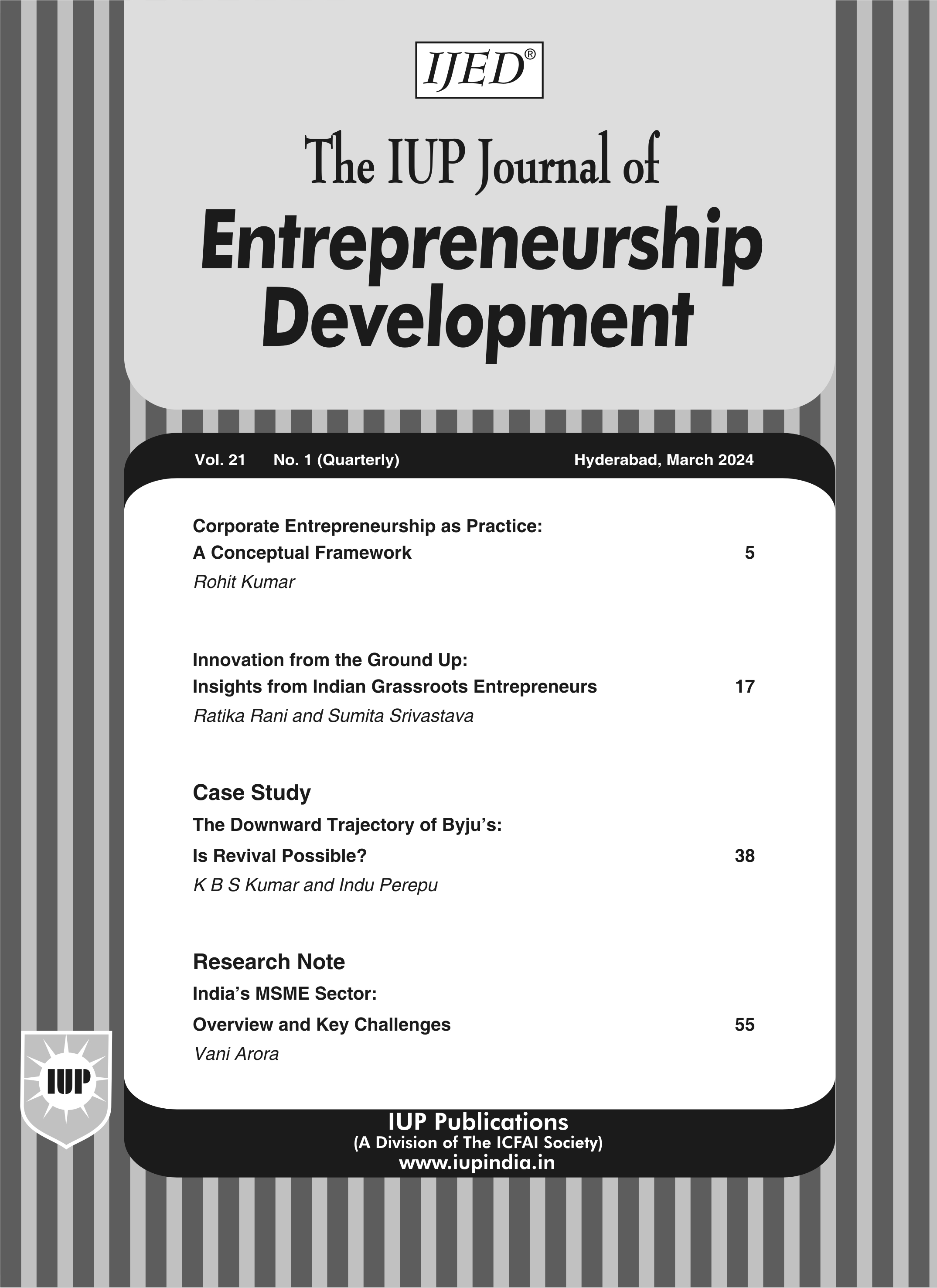
March'20
The IUP Journal of Entrepreneurship Development
Archives
The Future Scenario of Entrepreneurship Responsible for Significant GDP Growth
Afua Rita Buanyomi
MBA Student, WITS Business School, University of the Witwatersrand, Johannesburg, South Africa.
E-mail: afua85@gmail.com
Brian Barnard
Researcher, WITS Business School, University of the Witwatersrand, Johannesburg, South Africa; and is the corresponding author. E-mail: barnard.b@polka.co.za
The study comprises future studies and scenario analysis and aims to investigate the future scenario of entrepreneurship responsible for significant GDP growth (greater than 10%) in South Africa. Focusing on aspects such as social and cultural factors, leadership, management, organization, labor and skills, economics, trade, politics, markets, technology, infrastructure and environment, it investigates and reflects on whether Successful Entrepreneurship (SE) is indeed possible; what needs to change to attain SE, what is overlooked when it comes to business development, and what is obstructing SE. The research was conducted using qualitative research methods focusing on professionals close to entrepreneurship. Rather than focus groups or Delphi studies, the insights of entrepreneurship professionals were gathered using semi-structured interviews. The study found that a majority of respondents believe that SE is indeed possible, but it would require a concerted and collaborative effort from all stakeholders, primarily the public and private sectors and entrepreneurial experts to ensure that the right focus is provided, critical issues and challenges are realistically elevated to everyone?s attention, and practical, simple solutions are created and aligned with the backing of the right technology, policies and regulations.
Introduction
Given the empirical data, it can be argued that entrepreneurship generally has less than desired performance in several countries (Herrington et al., 2017). This occurs in the backdrop of established business development literature and policy. One is left with the fundamental question: Why is radical (very successful) entrepreneurship generally not witnessed more frequently, and why is it seemingly not that simple to achieve?
In this regard, future studies and scenario analysis promise to offer a unique perspective. As a strategy discipline, future studies is frequently used to delineate arriving at ideal future through back casting (Robinson, 1990; Slaughter, 1997; and Cook et al., 2014), as a way of providing strategic direction, as well as principal learning and insight (Inayatullah, 2006; and Ramos, 2006) Here, scenario analysis would also yield a different and unique outcome as compared to a descriptive model, because it not only considers the relevant factors at play, but also does it in a future context. In this sense, future studies may offer a unique perspective on business development. It helps to answer what competitive advantage, competitiveness and the business environment would be based on in the future. By implication, this is of relevance to entrepreneurship.
The study builds on strategic foresight and future studies and examines and delineates the scenario: entrepreneurship responsible for and contributing to significant (greater than 10%) economic (GDP) growth (from now on simply Successful Entrepreneurship (SE)). It investigates and reflects on whether SE is indeed possible, what needs to change to attain SE, what is overlooked when it comes to business development, and what is obstructing SE.
The study addresses the following research question: what does the SE scenario look like? It looks at aspects such as social, culture, leadership, management and organization, labor and skills, economics, trade and politics, markets, technology, and infrastructure and environment.
The study contributes to entrepreneurship, business development, and economic development literature and policy. It further integrates strategy (future studies) and entrepreneurship and delineates how higher levels of entrepreneurial success and output can possibly be attained.
The study focuses on professionals close to entrepreneurship. It considers the SE scenario, by concentrating mainly on culture, social factors, leadership, management and organization, labor and skills, economics, trade and politics, markets, technology, and infrastructure and environment. Rather than focus groups or Delphi studies, the insights of entrepreneurship professionals are gathered through semi-structured interviews.
A prominent premise of the study is that the SE scenario is indeed possible, if only under ideal circumstances, such that entrepreneurship professionals have little difficulty in delineating it. Entrepreneurship professionals are very aware of what hinders SE, also in anticipation of the future.
Literature Review
Culture
Social strife is rife and on increase around the world. In anticipation of the future, one needs to be cognizant of the social factors such as the movements in populations and resettlements, transportation, schooling, accommodation, antagonism amongst factions, mistrust, insufficient healthcare services and endangering civilians, who are often women and children (Botta and Abbasi, 2015).
SE requires entrepreneurs to fully understand these dynamics to come up with ways to resolve social strife in an effort to achieve continuous sustainable development (Botta and Abbasi, 2015).
The introduction of the internet has created greater connectivity and inter-connectivity than ever before, creating an elusive proximity to everything. The speed at which social awareness is erupting and the causal sequence of a fast-changing society requires one to be consciously aware of the changing environment and agile, to stay relevant, for SE to occur. The increase in social awareness can be used to change the narrative when it comes to sustainable development, creating a shift towards a more enlightened society (Botta and Abbasi, 2015) which is an ever-evolving process in the development of humankind as stated by Anderson (2004).
A minority of people strongly believe that automation/technology is the ultimate solution to resolve the social problems that society faces today. However, this becomes disconcerting to the remainder of society who are against increased deployment and advances in technology creating a dichotomy of sorts that could unravel itself in social unrest or a social revolution (Botta and Abbasi, 2015).
To move away from the current pervasion of patriarchy and selfishness entrenched in society, a new leadership model is required for societies to remain sustainable and to thrive beyond the current narrative. For change to occur, leaders will need to look at more collaborative measures to drive more mutually beneficial ideologies (Inayatullah, 2003).
South Korea is a prime example of a culture that has been reengineered and transformed. Earmarked as the next big thing when it comes to pop culture, some even attribute its success to their budding young population who have grown up to a democracy with a thriving economy and taken full advantage of all its opportunities. The democratization of their movies and music and being able to express their view freely has also led to their success. It is a perfect blend of the West into the Asian culture, creating a unique disposition to be modeled to the rest of the world (Dator and Seo, 2004).
Futurists favor the idea that advancements in technology come with changes in demographics and economic sectors. However, these changes are not exclusive to primary, secondary and tertiary sectors but extend beyond agriculture, manufacturing and services industries as well. One needs to fully understand the effect that fundamental changes to economies will have on populations as the world shifts towards a knowledge-based sector (Dator and Seo, 2004).
Though it is the view that western civilizations were built of Greek philosophy, it has become apparent that there are traces of similarities with the Roman society that was self-seeking, lustful, disloyal and malicious. There is a need for a new social fabric for sustainability (Botta and Abbasi, 2015).
There are talks that China will follow in the footsteps of the Koreans by 2020 and eventually give in to democracy. With the influx of Taiwanese and Japanese students who are returning from western worlds, it will be increasingly difficult for the Chinese to hold onto their current reform given the rapid transmittal of social culture and norms (Hoffman, 2014).
Meaning and Identity
The third-world countries are often based on a very communal system with identities strongly rooted in religion and other myths as guidance in their lives (Kelleher, 2005). Key questions that have eluded time remain, regarding who we are, where we come from and where we are going. Answers to these questions will provide meaning and identity to oneself (Judith, 2004). The focal point in understanding one?s identity begins with the study of history which provides self-knowledge with the understanding of what it means to be a mortal being. One key objective of future studies is this self-knowledge and to use it to create a shared identity in the pursuance of a meaningful life that takes future generations into consideration as well. If not properly managed it could result in absolute chaos and conflict with a breakdown in values and cultural interests (Demneh and Morgan, 2018).
A future that is seen in a negative light will experience stagnation and eventually die out, while a future that is depicted with optimism will ultimately thrive. Destination identity looks at areas within this narrative that can help shape the desired future through the shared beliefs and expectations with a united view of what the future should ideally look like (Demneh and Morgan, 2018).
With post humanism, meaning and identity are fundamentally changing. What this will look like is not yet known but redesign of the human civilization is imminent. Humans as we know them today will completely revolutionize going into the future, creating a completely different ecosystem and once again finding themselves asking the elusive question surrounding their identity and purpose as human beings (Cordeiro, 2003). With the inclusion of robotics, artificial intelligence and micro-chips, the difference between life and death, virtual and real, tangible and intangible, and natural and non-natural will all be challenged by this new humanism, completely diffusing the current formation of the human brain as we know it today (Cordeiro, 2003).
Social
Values
Values evolve with time; they replace older values, transform societal and political standpoints, and question the current system (Tibbs, 2011).
Values are an integral part of humans? life and form the foundation of who and what they aspire to be. Identities are also being chipped away by false advertising driving agendas that speak to the things people own and do. At its core, values are about who people are as human beings (Burke, 2011).
The information age introduces the relationship between humans and machines. Its characteristics are non-humanlike intelligence and individuality. However, the social wave has also emerged. This phenomenon has opened a number of opportunities and completely transformed the way people interact with each other, but it brings about an unintended consequence in that is creates a social gap. These factors require a new understanding of society and a better understanding of how it will affect the ways of working, interacting, socializing and how we define success and flourishment, not excluding our interactions with the universe as a whole (Burke, 2011).
Development
Tibbs (2011) highlights cultural creatives, moderns and traditionals as subcultures. The difference between all three is evident in what they value and how they reason and perceive things.
Evolution
Transhumanism takes a combination of different philosophies of knowledge to scientifically develop ways of circumventing biological confines currently faced by human beings. It uses technology to provide humans with an unprecedented advantage when it comes to life expectancy, methods of assimilating knowledge, enhancing physical and intellectual capabilities to supernatural levels (Cordeiro, 2003).
Behavior
The integration of social technology into society, particularly the younger generation, has affected behavior in that patience is almost non-existent, attention spans have reduced and it is all about self. Being exposed to this on a continuous basis could modernize the composition of how the brain works. More time is spent on the web and this could create a society where social standing becomes redundant. However, the consequence of that is increased levels of stress, less work-life balance, lack of personal freedom, and ultimately an unhappy society (Burke, 2011).
Leadership
It is becoming increasingly important to continuously adapt to the changing environment to survive, and leadership is at the helm. Leadership is about managing change which is, anticipating the future (Ratcliffe and Ratcliffe, 2015). This future will require a global shift within organizations from the mundane ?business-as-usual? way of doing things to transformative thinking to create a healthier, sustainable and thriving environment. It requires a change in mindset and the belief that the future is in one?s own hands.
Leadership is based on relationships, as opposed to having an individualistic nature to it, on the sole basis that becoming a leader requires followers and a shared purpose according to Ratcliffe and Ratcliffe (2015).
This notion that leaders of poor countries are unaware or ignorant of the implications of their poor decisions, which end up putting their countries into further disrepute is rebutted by Acemoglu and Robinson (2012). They point to the mechanistic Newtonian worldview and Fordist model of a factory-like system: if the right boxes were ticked, accompanied by the right level of investment in the right tools, organizational effectiveness could be easily achieved. Hiring the right people with the right skills, who buy into the vision and strategy of the company, creating the ideal culture and environment, and the right feedback, will result in a successful company.
The new way of leadership will be all-encompassing and revolutionary in its design, the focus being on: (1) collaboration, (2) sincere leadership, based on good values, (3) strongly built governments systems, (4) increased understanding of potential threats, complex problems and systems thinking, and (5) and the view that creative leadership can be informed by ?anticipation? (Ratcliffe and Ratcliffe, 2015).
Foresight
Critical future studies are a new way of thinking that is vital for societies going forward. It deconstructs the current way of doing things. It is about mastering how to view the world looking forward?how to create, sustain and maximize the future successfully. It sees the bigger picture and builds up a future-looking context around direction, how to get there, and how to overcome problems (Slaughter, 1998).
The current worldview sees human beings dominating over nature, and natural resources being utilized for the sole purpose of benefiting human beings. This belief includes factors such as: the denial of limits, the single-minded pursuit of material possessions that manifest as economic growth, the commodification of the basic needs of human beings, under valuing natural entities (resources), capitalizing on trade practices and future discounting. Slaughter (1998) calls this worldview and industrial ideology the civilization challenge and he believes that strategic foresight provides a number of ways to deal with these impeding challenges.
Direction
Critical studies take into consideration the existing biases associated with traditions, norms and ways of perceiving things. Through that process one can pinpoint certain cultural or social norms that seemingly may become issues if not addressed (Slaughter, 1998). Though people have the necessary tools and expertise at their disposal, they do not however have the social or political leadership skills or aptitude to act collectively or decisively as believed by Kapoor (2011). The biggest issue being faced particularly by developing countries is their deficiency in wisdom and their ability to further channel the wisdom they do have for the greater good. The world all round is in surplus of skills and experience but deficient in the ability to govern and lead with the degree of wisdom required for the future.
In simple terms the ?beyond strategy? approach refers to how businesses are too focused on what they term business planning which focuses on resolving current anxieties when the true richness of data and information can be found through dialogue and conversations that people have with each other (Kapoor, 2011). Empowering people to do things is not the same as giving people power to do things (Blass, 2013). Empowering people involves equipping them with the necessary tools to do something whilst power affords a person the right to do. True leadership is about providing an alternative view of the future whilst creating a conducive environment for people to thrive and get things done.
Ethics and Morals
People naturally tend to resist change and prefer to continue with the status quo. The leader must be able to deal with this (Blass, 2013). Moral values and ethics are the foundation under which the creation of a better tomorrow will be determined. The success or failure of this rests on the virtues held by leaders and their exertion of the right level of wisdom. There is no room for future leaders to take a neutral stance according to Kumpe and Chen (2014).
Institutions
Economic and political institutions, as we know them, will still play an integral part in the economic success of countries (Putterman, 2013).
Labor and Skills
Education
Change in education is eminent. Education has evolved through the centuries, but currently struggles to stay ahead, given the pace of change. The focus is more on human needs. Increasingly, people need to continually educate themselves (Dian, 2003). Knowledge dissemination must become wider?more spread and extensive (Kapoor, 2011).
Universities have lost their power through the introduction of easily accessible information through the internet (Barnatt et al., 2016). University programs must become a lot more proactive and forward-looking (Slaughter, 1998).
The requirements of success may entail fitting into corporate culture. Education policy and philosophy may be very narrow-minded. Human development takes place at a personal and spiritual level. Education should transform from being about a transferal of facts and skills to being about transformation and evolution of self (Whitty, 2001).
Education needs to be less theoretical and more practical-based. To be able to compete in the fast-paced technological world of today, companies require better social skills/emotional intelligence and creativity (Dian, 2003). Education should encompass learning the capacity to have close communication/dialogue, understanding complex relationships/systems, understanding social transformation, ability to contextualize events, using technology skillfully for social image and intercultural skills. Ultimately education needs to evolve and cater to the individual needs of its learners (Dian, 2003).
Focus
In trying to drive the importance or preference of Science, Mathematics and Technology in Commerce, the effect has been limiting students from expressing themselves through dialogue and being masters of their own destinies. The Arts have a higher propensity to expose children to interactive learning and develop the ability to think critically, than any computer would (Whitty, 2001). Wisdom needs to become part and parcel of what is taught to adults as there is an increasing agreement in countries to cultivate basic survival skills in human beings, such as the exposure to the varying degrees of literacy skills available, numeracy, complex problem solving, relationship building and system thinking skills (Dian, 2003).
Factors of Competitiveness
Countries? competitive advantage evolves, and currently it is shifting towards intellectual strength. Chung (2001) notes four levels of knowledge: data, information, knowledge, and intelligence, with the latter as the highest. Higher levels of knowledge is what truly empowers individuals and countries.
Science, Technology, Engineering and Mathematics (STEM) is politically motivated and driven, due to government?s inability to redefine the higher education system to drive a scientifically and technologically equipped economy to remain relevant in the digital era. This agenda emphasizes the need to safeguard talents and skills necessary to remain competitive in the science and technology industries in the long term (Barnatt et al., 2016)
Management and Organizations
Representation
Out of the largest 100 economies in the world, 51 are privately owned and to top this off, the number of countries within this selection is steadily decreasing meaning that the global economic powerhouses that have been created by our societies are held by a select few. Though these companies have the resources and ability to do good with this power, one cannot overlook the large amount of corruption, unethical conduct and illegal behavior that has been exhibited by them over the years (Kelleher, 2005).
Corporations of the past no longer exist in their traditional sense. They have now been replaced by large business networks that use their expertise in various areas to provide their communities with a competitive advantage. How governance will be structured going into the future, will be largely driven by these networks of global republics (Kelleher, 2005). Developing countries no longer trust developed countries and international organizations.
Corporate Responsibility
There are three fantastic ideologies that underpin the thought processes within most businesses today and similarly weaken the way of doing strategy amongst them: (1) The imaginary idea of having limitless growth, (2) The unrealistic notion that there can be actions without repercussions, and (3) The fantasy of disconnectedness (Burke, 2011). Seemingly there is a lack of trust in the state, business and international bodies to behave ethically in society (Kelleher, 2005).
Irresponsible behavior of businesses must be governed. It may require a culture that puts emphasis on moral development and shared loyalty on business and national objectives, as opposed to an individualistic mentality (Kelleher, 2005).
Large corporations are becoming increasingly removed from the realities on the ground (their people) and their decisions are being motivated by money. Currently the governance system globally, consists of the world?s most powerful economies made up of a combination of multinational corporations and powerful industrial countries (Kelleher, 2005).
There is an increasing shift in consumers supporting businesses that demonstrate more social and ecological responsibility. This is being driven by the current trends like the reduction in fertility rates in the USA as well as the shift in societal standards in developing countries (Kelleher, 2005).
Economics, Trade and Politics
Fiscal Policy
Armed conflict demonstrates the impact on infrastructure, investor confidence, and the composition of government spending (Botta and Abbasi, 2015).
Economic Ideology
Education is driven by the need in the market and the practical application of it. However, there is a gap to provide educational programs that simultaneously equip learners with skills and attitudes required by organizations and prepare them for the needs of a sustainable planet. Unfortunately, the unsustainability has been largely driven by deliberation within the markets (Kelly, 2003).
The purpose of education systems, governments and organizations to date has been to create opportunities for economic growth in a dynamic and ever-evolving environment but that said, there is growing consensus within business schools for limitations on growth (Burke, 2011).
The way the industrial value chain currently works, is to acquire natural resources from Mother Nature, process them into products with temporary economic value and eventually dumping them back into the environment as waste. This process worked when the level of output was relative to the size of the earth. However, with the increased growth that the world continues to experience, this is becoming a serious concern. Nevertheless, situations like these provide opportunities for new ?green? technologies and infrastructures to be created to respond and tackle these resource-depleting challenges (Tibbs, 2011).
Some of the possibilities identified whilst taking a futurist view of Penang cities were, too many robots taking over, rewiring of cerebral matter, geopolitics of energy evolves due to the entrance of cheap energy, Internet of Things (IoT), and shifts in demographics and climate (Cruz and Villanueva, 2014).
Factors of Competitiveness
The future economy of politics will cease to be about information and rather be driven by imagery. The power struggle will be to control content and its associated meaning, moving from the information society to the dream society. The information society will become null and void through the process of automation by making human beings redundant and machines replacing their skills. The electronic industry can be split into three waves:
(1) hardware, (2) software (current situation), and (3) content; meaning revenue will come from the inherent product and not the software used to deliver the content. This will change the way business is conducted in the future and will give birth to an era of great storytellers of the 21st century (Dator and Seo, 2004).
Political Power and Dominance
A world where free and fair elections will be conducted, and leaders will be selected on the basis of their wisdom, intellect and personal strengths, is where the future lies. Just like the ancient Greek politicians these leaders would work for marginal pay and use the wealth of knowledge acquired throughout their life span for the betterment of their society (Botta and Abbasi, 2015).
International dominance is in turmoil. The US hegemony is declining, and transitional countries like China and India are rising in prominence. Yet, the battle for world dominance is far from over (Kelleher, 2005).
The credibility and legitimacy of international institutions, like the United Nations, are questioned, and some argue for a restructuring, at the same time asking what the ideal structure would be (Kelleher, 2005).
Though the technical expertise is there, and the technology available, green technology can only be sustainable and effective if it is supported by the required changes in behavior. In this regard, several propositions have been made, but require a strong political will from participating countries (Tibbs, 2011).
Residents of countries like China and the US prefer collaboration over dominance. The battle over superpower status is not over?China may be challenging the US, but itself has several strong contenders, like India, Brazil, Thailand, Taiwan, South Sudan and Libya who continue to experience strong economic growth (Hoffman, 2014).
Current global power houses would need to look past the short-term losses to establish a mutually beneficial scenario for the long term. We have possibly reached the end of what we have known as western dominance, though the West will remain a strong civilization for years to come. In the past there was no real interest in Asian societies, but it will become increasingly important going into the future and the dialogue should now be about how the West will adapt to this new renaissance (Kapoor, 2011). What is required as a collective is a new way of thinking whereby traditional diplomacy needs to progress from its current static inter-state base to a mega-diplomacy mobilizing coalitions across a varied number of stakeholders with different degrees of influence, power and strengths to solve global challenges together, and doing so in mutual respect and comradeship (Kapoor, 2011).
Markets
Factors of Competitiveness
User experience is becoming increasingly important in businesses differentiating their goods and services from the cluttered, over-stocked and materially-congested trade environment. The appearance of beauty and self-expression are key attributes that are emerging from the changes in culture, business and technology. It is not enough just to have an offer now, it needs to be physically and emotionally unmatched in its appeal to consumers (Dator and Seo, 2004).
The use of middlemen is becoming increasingly outdated as consumers have access to a plethora of information at their fingertips. They can decipher information at an extremely fast pace and are more aware than ever of their needs. To remain competitive in the future, their offerings need to be transcendent, meaning apart from the staple things such as quality, price, value for money and effectiveness, companies need to be conscious of the conditions in which their products are being produced whereby children are not being exploited, the environment is protected and labor practices are being rigorously adhered to (Inayatullah, 2001).
The next level of consumer data will equip customers with the necessary information at their disposal. Purchase decisions will be aided by instant feedback regarding the immediate impact to self, whether it be emotionally or physically, and access to information about origin. It will close the gap between natural behavior and what is best for the consumer and will equip consumers with the necessary tools to make wiser decisions based on real-time data and create a transparent and open smart market (Inayatullah, 2001).
Capitalism works based on supply and demand and more importantly requires access to resources, whether natural or physical and leads to increased profits. With the rise of globalization and virtual reality, this has allowed private enterprises to gain even more access and a wider footprint. However, this has simultaneously opened the world to workers alike to areas and markets that were previously inaccessible allowing all participants fair participation. This may change the way capitalism has always worked in the past given the increase in competition and the rise of smarter markets. Leading to a scenario whereby labor could be as fluid as money and no longer restricted by inter-governmental systems, creating a worker uprising battled over the internet (Inayatullah, 2001).
What would this mean for the future of markets and businesses? A scenario where power and money move from the hands of corporations to consumers as they become smarter in their way of doing things. Where supply and demand match, resulting in an elimination of monopolies and government feather-bedding, possibly creating a worker?s market of global proportion that lives entirely on the web. Or will this just lead to a shift in power to the ones who own the internet lines, the intellectual property and provide the service? (Inayatullah, 2001).
Technology
Foresight in technology is about scanning the market and developing new technology for the future, whilst simultaneously understanding its impact on society and the environment, to create a sustainable future (Technology Futures Analysis Methods Working Group, 2004).
Factors of Competitiveness
As the world evolves and instant information becomes more and more readily available, this will have a tremendous impact on technology and production. As customary, several technologies will be strong drivers of the future. Examples include: getting businesses to work at a level whereby one?s companies waste can be another company?s source of raw materials (Inayatullah, 2001). The next phase from a giant e-bay for workers, will be nanotechnology. The ability for organizations to create any product they can fathom by skillfully influencing the features from a molecular level. The likes of NASA and various others are entertaining the idea of lab-grown meat versus real livestock. The idea that the world?s annual supply could come from the production of one cell always seemed unfathomable. The technology will reduce pollution, reduce drugs used on livestock, benefit the environment, and increase human well-being over the long term (Burke, 2011).
Technology Ideology
According to Ramos (2017), the new concept of cosmo-localization looks to challenge the current status quo through the rise of cultural and natural resources commonly owned by all members of the society (known as commons) and combining this with new technologies within manufacturing that completely transforms the current method of production. The archaic way of doing things is to use the intellectual property of a single company in the manufacturing process, produce the product in a central location even if materials are globally sourced and then export the final product around the world. Cosmo-localism disrupts this way of thinking in the sense that it is of the belief that everyone should have access to the intellectual property and have the ability and opportunity, using new technology, to manufacture and produce items locally for local consumption and expertise.
Infrastructure and Environment
War-torn countries and conflict areas are not just leaving devastation in the lives of civilians but are also severely impacting their infrastructures through the damage being caused on water and electricity systems and lines, sewage plants, food value chains and most importantly their public health systems (Botta and Abbasi, 2015).
China, an uncontested leader in emitting greenhouse gases, will produce by 2015, at its current rate, 50% more than the US and by 2025 their air pollution is expected to be 70 times worse than it currently is. Air pollution has reached critical levels to a point where it has become a cause of mortality for the nation through increased burning of coal and emissions. Their surface water and total land area are also under immense threat (Hoffman, 2014).
Given the rapid rate of urbanization happening within the Asian continent with close to two billion of its population residing in urban areas, the question that faces town planners, mayors and regional leaders is how they plan to address and manage this compounding challenge (Gale et al., 2015).
Several aspects of SE as a scenario were considered: social, cultural, leadership, management and organization, labor and skills, economics, trade and politics, markets, technology, and infrastructure and environment. All of these indicate a continuously and rapidly changing landscape and environment, and several factors that entrepreneurship must address, in order to be successful, particularly in the future. The direction and shape that a number of these factors will take, are unclear. Consequently, what SE looks like, and will look like in the future, is unclear.
Considering this, the literature review concludes with the research questions: what does SE as a scenario look like? As part of this, it involves and looks at the aspects: social, cultural, leadership, management and organization, labor and skills, economics, trade and politics, markets, technology, and infrastructure and environment.
Data and Methodology
Research Paradigm
The two most commonly used research methods are: quantitative and qualitative.
Quantitative research is numerical in nature, and requires data to be statistically measured, requiring the data to be received statistically or converted to that format (Turner, 2010).
Qualitative research mostly addresses non-numeric data and seeks to understand meaning and interpretations, the emphasis being on how social actors understand the world around them and its associated behaviors, perceptions and experiences?focusing more on the richness of the experience than a cause-effect relationship like quantitative (Willig, 2008). Smaller datasets are reviewed and seek to unpack depth rather than breadth (Blaxter et al., 2006). Due to the subjectivity it demands a level of immersion with the respondent (Blaikie, 2000). A qualitative method was the most appropriate for this study as it gathered knowledge through interactions with industry experts, to understand their reality, perspective and experience of entrepreneurship in South Africa. This approach is known as a phenomenological approach (Blaikie, 2000).
Research Design
Qualitative data can be sourced through individual (semi-structured/unstructured), paired and grouped (focus/nominal interviews) techniques. Focus groups are used to collect data from the interactions and discussions of the group and tend to be unstructured. Conversely, nominal groups are more structured and selective of the group composition with information individually obtained and thereafter shared with the group. A nominal group technique, known as Delphi, could be used as an alternative method. Its distinguishing factors are that the selected individuals are usually skilled experts in the same field of work and usually encompass predictions of some sort (Ritchie et al., 2003).
Individual interviews are either unstructured or semi-structured. In the former, the interviewer has a predetermined idea of what is expected but cannot circumscribe the responses, leaving them open to interpretation and protracted. Conversely, the most utilized being semi-structured interviews, provide structure and require some uniformity in how questions are posed (Willig, 2008). Quite conversational in nature and the respondent can be probed to encourage participation. Semi-structured interviews were conducted, providing the researcher with the platform to obtain a comprehensive understanding of how people interpret their lives and experiences (Harrell and Bradley, 2009).
Below are some advantages of semi-structured interviews as described by Darlington and Scott (2002):
- Face-to-face discussions provided an opportunity to check and adjust throughout the interview.
- Misinterpretations were clarified and corrected immediately.
- Proximity to respondents made them treasures of information.
- Interviews are versatile due to the conversational nature.
- Brilliant method in understanding people?s perspectives, especially when not observed directly.
- Retrospective and anticipatory in nature. Disadvantages of semi-structured interviews as described by Darlington and Scott (2002):
- Very subjective and leave too much power in the hands of the researcher.
- Time consuming.
- Respondents could be dishonest in their responses in comparison to their reality.
Population and Sampling
The right level of representation in the study is crucial, starting with the correct composition of the population. Population being a set circumstance, then aggregated based on the same characteristics (Blaikie, 2000). The population of the study was limited to entrepreneurship expert professionals, in South Africa.
Selecting a statistically representative sample from the population is known as sampling (Turner, 2010). Purposive and probability sampling methods are used, the most common being purposive. The objective being to obtain respondents that possessed a wealth of knowledge on entrepreneurship to gain depth of knowledge (Turner, 2010). Purposive sampling was used to meet the selection criteria, being experienced professionals within the entrepreneurship echelon.
Characteristics required to meet the selection criteria:
- Required adequate experience (>3 years).
- Had to be closely related with the success of entrepreneurship.
- Government officials were excluded based on their limited exposure of success/comprehension of entrepreneurship.
- Ordinary entrepreneurs, outside the highly experienced, were not considered based on limited experience. Venture Capitalists (VC) and entrepreneurship consultants were considered, as they have a broader, more diverse and frequent exposure to entrepreneurship.
The sample size was restricted to 10 interviews and of the belief no added value is gained, reaching saturation.
Candidates were sourced telephonically or via email through professional networks and online social media platforms or referrals.
The Research Instrument
A topic guide presented as a research instrument was used to indicate the key themes for the study and provide visibility to respondents upfront (Ritchie et al., 2003). The structure emphasized the importance of logical questions that covered the full spectrum of the literature review, to obtain comprehensive understanding (Willig, 2008). Furthermore, acting as a reminder to ensure the researcher covered all the required areas. Semi-structured interviews were conducted over a duration of 60 min.
Data Collection
As stated, face-to-face semi-structured interviews were conducted with the use of purposive sampling methods to ensure that the salient criteria for selection was met. The key criterion being experts in the entrepreneurship field in South Africa.
A detailed research instrument (see Appendix) was distributed to potential respondents, providing a breakdown of the areas that would be covered as well as assurance regarding their confidentiality, especially regarding the use of a tape recorder. To ensure all issues of ethics were adhered to, a consent form was sent to the respondents beforehand, detailing the research intent, data collection approach and length of time required from them.
The use of a tape recorder provided several benefits to the researcher and the overall quality of the interview due to the following reasons as described by Bell (2014):
- Created connection with the respondent through eye contact.
- Ensured engagement throughout the interview.
- Accuracy of information ensured, and omissions limited, by not basing the transcription on memory alone.
- The ability to replay the recording assured the right level of insight obtained.
- Lastly, it allowed the researcher to pay notice and note, any key themes that came through. The respondent had to be aware of (Bell, 2014):
- The use of the tape recorder inhibiting full disclosure.
- The length of time required for transcribing.
- The possibility of bias.
- Consideration and respect of the respondents? time and schedule.
- An appropriate venue that would allow the respondent to be at ease.
- Being courteous.
Data Analysis and Interpretation
The data analysis made use of thematic analysis methods from the transcriptions of the tape recordings with the respondents. The analysis utilized a framework developed by Ritchie
et al. (2003) which encouraged open and thorough management of data in a 5-step systematic format
- Familiarization: The researcher familiarizes themselves with the raw data from the onset by immersing themselves in it. Listening to the recordings, reviewing notes and being aware of key themes that emerge.
- Identifying a Thematic Framework: This provided the skeleton for the analysis to be conducted. The process involved scanning the environment for the main themes, ideas and constructs that emerged to create the thematic outline.
- Indexing: Taking the core themes and combining them with relevant themes that emerged from the interviews and aggregating them to key category sets.
- Charting: It requires a summation of the key areas within the data but retaining the richness of information provided by the respondent to not lose the essence of the message.
- Mapping and Interpretation: Lastly, combining the essential traits collated from the data, thereafter all information is deduced to a comprehensible level.
Validity and Reliability
Validity
A precise definition of validity is provided by Bell (2014) and depicts it as the ability of the research to provide concrete and credible results. Validity is further distinguished as internal validity and external validity. Internal validity refers to the cause-effect relationship between variables; simply put, it measures the accuracy of the study (Malhotra and Birks, 2003). External validity measures whether the causal relationship found in the internal validity can be generalized (Malhotra and Birks, 2003). Internal validity was utilized and managed through feedback received from pilot studies, to ensure the intention of the research instrument was measured. External validity was not a priority for this study given the research was exploratory in nature and focused more on respondents' personal insights, than a generalization of the findings into the population.
Reliability
Reliability is the extent to which the results obtained from a technique or practice remain trustworthy ceteris paribus (Bell, 2014). Reliability was safeguarded and improved by ensuring interview questions were clear and unambiguous, by following the template the semi-structured interview schedule provided, and by ensuring participants understood the questions clearly and did not deviate.
Results
The results are broken down into the respective themes and sub-segments.
Culture and Social
Worldview, Mindsets and Values
Some participants believe there are differences in the world views across ethical groups, however they are not determinants of success. Depending on the kind of support or situation the entrepreneur finds themselves in, the view is they tend to either have a survivalist mindset or alternatively see entrepreneurship as a liberating experience that promotes independence. However, society is still of the view that entrepreneurship is a risky alternative to the 'secure' traditional white-collared job.
Participants felt the public and private sectors need to play a more noticeable role of raising the awareness and importance of entrepreneurship. Government needs to change the rhetoric and provide a clear vision for entrepreneurship with politics as an enabler. It necessitates a strong message, supported by the right policies and procedures, to be a catalyst for change in the mindsets of society.
Some participants believed the private sector should carry equal responsibility in driving the success of entrepreneurship by instilling a culture of innovation and reducing the tendency to exploit, undermine and patronize. Thereby scaling down on the strength of monopolies and the existing power structures to create a more competitive environment.
The dominant view was no two entrepreneurs are the same or fit a mold. There are only probabilities, some higher than others. But some commonalities observed are in having curious mind, flexibility, a wining mindset and slightly dysfunctional, i.e., trying to prove a point. The participant said "success cannot be pin pointed on one's set of values."
Social, Cultural and Spiritual World
Some believe that the entrepreneurs' social or spiritual stance are not determinants of their success or failure; however, their communities and surrounding do take strain from the pursuit of their vision. Another view was that a supportive culture was neither a deterrent nor motivator. The correlation was rather with their background, upbringing and status. The view was that society could do better at giving entrepreneurs the due recognition and commendation they deserve.
Further to this, the participants believed that entrepreneurs require persistence, determination and discipline. Discipline assists the entrepreneur in focusing on the end goal through the lows they experience until things smoothen out. One participant was of the view, holism was a better goal to emulate.
Social Consciousness and Awareness
Participants' outlook was that it is imperative for all stakeholders to have a clear, concise and standardized definition of entrepreneurship, the role it plays and the potential benefits if implemented correctly. The same sentiments need to be echoed to society to raise awareness. Some believe entrepreneurship is about pulling all stakeholders in to enable capacity for a more egalitarian society.
Some participants are also of the opinion that self-awareness is a necessary requirement for the entrepreneur to properly position and equip themselves.
Social Transformation
Participants believe that society requires a change in mindset through exposure to more entrepreneurial success stories. It is imperative that society understands the importance and role that entrepreneurship can play, especially in shifting the power structures.
However, the government is seen as a key player in championing entrepreneurship and creating a conducive environment for it to thrive. However, the view is that it needs to start with overhauling of the policies to reduce the onerous requirements on entrepreneurs and improve the ease of doing business.
Human Development
Participants believe development requires a level of independence and flexibility. Entrepreneurship needs to be a viable and lucrative alternative to enable a change in perceptions.
There were some instances where participants believed that a change in the education system was vital, especially in making the contents and skills training more relevant, innovative and entrepreneurship friendly. However, parallel to that, students should be taught to try, fail and try again as a form of building character.
Individual Politics and Political Development
The view is that entrepreneurship is a capitalist system, though the extreme may not be sustainable and not all parties may be in support of it. Ideally, entrepreneurship should be depoliticized. Politics should be an enabler of change and political agendas and power plays should be negated. The onus is on government to drive a collaborative and inclusive discussion with all stakeholders to be able to come up with comprehensive solutions.
Another view was that politics was extraneous, internally or externally. It is a matter of perspective, choosing to see it as a threat or opportunity to exploit. The entrepreneur just needs to keep abreast of the changing environment.
Technology and Social Worlds
Some participants stated that technology was here to stay, however, with freedom comes responsibility. Technology should instill, maintain and drive the right values and culture within the society. Some method of regulation might be necessary as time evolves to ensure the social fabric remains intact. Many participants believe that technology and the use of technology depends ultimately on the entrepreneur and their ability to exploit it. It is a matter of perspective.
A participant posed a question and said "technology is dynamic and increasingly intangible. If successful entrepreneurs create robots and artificial intelligence, which dehumanizes us. Is that success or is it failure?"
Meaning
The predominant view was that entrepreneurs find fulfillment either from material success or through a higher purpose. Entrepreneurs require a project or vision to work on and secondly affirmation. However, the latter may not come immediately and that is where several entrepreneurs fall of the wagon. That could be related to vagueness of the vision, lack of emotional strength or the practical realities the entrepreneur is faced with.
Unity, Convergence and Shared Worldviews
It was mentioned that entrepreneurship by its very nature is individualistic, thereby making it fragmented, but in some instances converges, the difference being the entrepreneur believes they are different/unique. Fragmented is "I" where utopian is "we", the latter being egalitarian thinking. The participants do not believe in a utopian world, if any it is negligible. At times it happens that the outcome may initially be to create convergence, but the views end up becoming polarized and fragmented. However, one participant believes SE has collaborative features and should not be about just trying to achieve things for their own benefit but for the greater good.
The participants believe that the government's simply redistributing wealth may be the populist thing to do for now, but is not sustainable culture, especially not one conducive for entrepreneurs to grow. It inhibits entrepreneurs because it does not reward constructive things like hard work, productivity, innovation and creativity.
Leadership
The predominant view was that SE will move away from a hierarchical to a flat structure. Entrepreneurship should be driven by leadership and given the proper support, attention and focus. Leading through dialogue and articulating a clear vision that everyone wants to promote and pursue despite his or her presence. Leaders need to be self-aware and understand their blind spots and strengths. The onus is on the entrepreneur to develop their capabilities depending on the life stage of the business.
Equally some participants believe that political leadership should drive a strong message from the top and the implications of their decisions on entrepreneurs understood and preempted. But the implementation should be led by the private sector and facilitated/governed by government. Policy is the key enabler that government can utilize to assist entrepreneurs. It can be with subsidies to help support entrepreneurs or working closely with banks to mitigate some of the risk associated with rewarding of SME loans.
Wisdom, Foresight and Direction
Wisdom comes from entrepreneurs' experiences, failures and successes over the course of their journey, the dissonance between the two. The lessons learned between the peaks and troughs, build wisdom. Foresight on the other hand is random and is a function of experience. It is the entrepreneur's ability to discern between cause and effect of patterns in the past. Very often foresight is a matter of refining one's ability to understand patterns. In addition, foresight is a dose of intelligence and lateral thinking because very often one's foresight is a function of linear thinking which can be quite inhibiting on the entrepreneur. Direction is about trying something new and dependent on the individual. In the end it is a combination of intelligence, experience and reflection.
Another participant views wisdom as the willingness to learn, be taught and be led.
Ethics and Morals
Ethics was defined as the difference between right and wrong, which is a constituent part of morality. And morality being a broader sweep at the norms of society.
In addition, another participant believes that ethics are discerned by the society and what is considered bad in one may be accepted in another. But the view is, a higher moral code means higher trust, which leads to greater efficiency and profitability. When ethics and morals are held in high regard it helps to shape the society and create a fair system. For entrepreneurs corruption is like cancer and can only lead to their demise. Entrepreneurial opportunities should be based on meritocracy and fair competition, rewarding people for driving the right behavior and values. To drive openness and transparency, government should have policies and regulations based on clear key performance indicators that will help, direct and drive the desired behavior.
Buy-In
Participants are of the view that entrepreneurs receive buy-in based on the clarity of communication and the compelling nature of the vision and direction given. Creating that foundation where everyone sees the idea and then co-building, co-designing, and
co-manifesting. Making it a consultative process across the value chain.
Many participants believe that entrepreneurs should seek support in good mentors, business coaches or programs and incubators. The red tape and compliance requirements associated with starting a business are cumbersome and become a deterrent and should be reviewed to obtain more buy-in, better and more appropriate tax reforms for entrepreneurs.
It is believed that institutions should be incentivized to assist Small and Medium-sized Enterprises (SMEs) with their compliance. To help improve the risk profile of entrepreneurs, government can subsidize SMEs through a fund administered by banks and underwritten by them, equally sharing the risk and driving growth.
Institutions
Infrastructure is seen as an enabler, but it requires consistency for entrepreneurs to know how to navigate through. However, the entrepreneurs' role is to understand the opportunity or threat created by it and work around it. Institutions have been known to inhibit entrepreneurs' success but more are required and should be positioned to support, encourage, create a conducive environment that helps with pertinent functions required at the start.
The educational infrastructure requires recalibration across all levels. Students and teachers alike should have practical exposure to entrepreneurship and critical skills that can help assist in self-sufficiency in future. Public Private Partnership (PPP) are crucial for around SME finance but should be managed from corruption and nepotism. The commercial experience can only be advantageous.
SE Implementation
The view is that jobs cannot be created by government without having enough entrepreneurs who are interested and attracted to the idea. More so those with the intention to impact society for the greater good of the economy and to add value to the consumer journey and not simply for material wealth. What is crucial is the creation of a conducive environment.
Dominant Ideologies
Participants believe capitalism is flawed, nuanced and must adapt to the environment that it operates in. Whether it is conscious capitalism or pure capitalism, or conscious communism or controlled capitalism, it cannot be labeled because it is transient, keeps changing. Entrepreneurship is far more successful in a capitalist society. Another view was that the African ideology is just as good, if not better in many ways but simply misunderstood and that the brutality of capitalism is not good and cannot be so idealistic. So there needs to be a proportionate balance between socialist and capitalist ideologies.
Management and Organization
Organizational Constitution
Some participants are of the view that organizations will transform to remain relevant from leadership right through to organizational composition. Driving more equal structures, pulling resources and utilizing the knowledge and experience available efficiently and effectively to collaborate. Hybrid models consist of a networked organization and cascading leadership.
Quite integral is the need for entrepreneurs to be educated and informed in how to protect their intellectual property, and those who steal it should be penalized.
Labor and Skills
Education
Most participants believe that entrepreneurs should self-educate and drive their own development. However, experience is still the best teacher. Successful entrepreneurs by their very inquisitive and curious nature, know how to find information. Experience and the entrepreneur's ability to fulfil a task is what is crucial. Education is not harmful, it is just an enabler. Education would not make the entrepreneur successful, experience will. That is the defining factor. It is important that the entrepreneur constantly refreshes and contextualizes skills to the needs of the business. They believe entrepreneurship should be incorporated into the school curriculum to provide kids with more options. We have to change the narrative about the traditional avenues being the only way to succeed, and encourage other avenues such as vocational and practical training.
Human Development
Some participants mentioned that human development is a combination of relevance, meaning and appropriate training which is fit for purpose, and not necessarily the syllabus that we have at school at this very moment. Development is also required through technical skills and other non-skilled areas like leadership or compassion.
Education Focus
It is believed that STEM is important, but there is an important need to create awareness of business acumen, financial literacy and agency to create anything around whatever ones talent, skills or focus is. Critical thinking is also going to be important. Having the ability to think for oneself and obtain the relevant info to move ahead without relying on someone else. Social skills are equally as important but there is a place for both and we need to find a balance. The curriculum requires refining, as many school goers leave school in their adolescent years. At this point, the choices should be clear and those who want to pursue vocational or entrepreneurial skills can branch out but having received training on the softer skills as well. This requires conscious awareness from the government. The future is increasingly requiring different skill sets and the education system needs to equip students with the tools they require to make a living. But for this to happen it is important to showcase the different facets of success to elevate the profile of entrepreneurship in the society.
Similarly, participants believe organizations will lean more towards training people regarding where they see a gap in their knowledge base versus the current wave of innovation, due to limited resources. However, we need to still encourage lateral thinking through non-traditional forms of training.
Economics, Trade and Policy
Economic Policy
Some participants believe in a liberal, free and democratic economy that is not dogmatic or constraining. The economic policy regarding entrepreneurship would be around subsidized financing to support and underwrite loans for entrepreneurs and SMEs. Offering incentives to big corporations to work with and assist entrepreneurs, with no political agendas attached. One participant is of the view that capitalism creates a conducive environment.
Economic Ideology
Some participants believe one cannot dictate the dominant economic ideology under SE. The national culture and behavior can only be guided at best. Entrepreneurship can also change cultural behavior by succeeding in their endeavors. The belief is that without consumption there is no demand, which means no business. The downside includes the waste aspect and the environmental effects of plastic. It requires evolving of conscious consumerism to survive. Another view is that entrepreneurs should look at how they can take what is already being consumed and reuse, recycle or upcycle. SE should be about doing something for the greater good or with long-term effects in mind, or they just become a business owner who makes profit.
Competition and Competitiveness
The participants' outlook is that if entrepreneurs have knowledge they can get the resources, but simultaneously without the resources they may not be able to gain access to the knowledge. Others are of the view that competition will not be based on knowledge, but rather be competing on change-the dismantling and the reassembling of knowledge, ability to unlearn and the speed at doing this, and competing on agility and adaptiveness rather than knowledge. Knowledge does not mean doing the right thing. Knowledge is available, if the entrepreneur looks for it. It will be based on resourcefulness and networks. The knowledge and resources are readily available to creatively and innovatively tie them together to create something. Competition is a necessary and healthy requirement, but entrepreneurs must be more collaborative to achieve more. It may sound esoteric, but people are not designed to fail but embrace opportunity and possibility.
Fiscal Policy
Some participants are of the view that so long as the rules are clear and consistent, the entrepreneur can adapt to it. Priority needs to be on the creation and support of entrepreneurs. Most importantly policy makers need to be cognizant of and understand the impact their decisions have on entrepreneurs. Reports such as King 4 that focus on transparency and the basic tenets of sustainability and a circular economy are vital. Fiduciary duties are an essential regulation that is required so that entrepreneurship is done in a manner transparent and sustainable.
However, one participant believes that regulation in South Africa is more representative of societal challenges and quite often the two do not speak to each other. Fiscal is just one aspect of the system, and tax incentives and grants should be more freely available to entrepreneurs but implemented by people with commercial experience. The pressing challenges are seen to be around bureaucracy and corruption. The view is that the private sector needs to play a more collaborative role in driving change.
Power Relationships
Power relationships are viewed as external or environmental factors. The entrepreneur's role is to determine the opportunity and threat and take advantage of it. Whether a superpower is good or bad, depends on how the entrepreneur positions themselves. Some believe that the power must and will shift at a macro level and eventually become less controlled.
A few participants believe the most effective way to shift the power, is through storytelling. By sharing success stories that capture the vision, increase the belief and build momentum to obtain buy-in. Entrepreneurs should not fully adopt or sell out to the western model. There should be some balance between socialist interventions and capitalism. With the right support, entrepreneurs can dictate and impact politics and relations and minimize the strength of the monopolies.
Markets
Constitution of Markets
A common view is that markets would require a change in supply chains, rather than a change in markets. It is about the reduction and concentration of supply chains. It requires strategically coercing the introduction (concentration) of entrepreneurs and SME's upstream, at the start of the supply chain process. Large corporations should be incentivized for making use of smaller suppliers and provided with additional points to drive an agenda rather than using rules. However, the challenge always comes down to capacity. The view is entrepreneurs need to be assisted with bridging capital based on contracts they won and customers they have, like invoice discounting or reverse factoring as collateral. Trading the future payments due to entrepreneurs by going to the debtor directly.
Another participant is of the view that the markets should be free; partially governed and controlled. Furthermore, they should have less regulation and freedom to enter surrounding markets.
Premises of Competition or Competitiveness
Participants are of the view that the focus will be based on actual delivery, service, quality and innovation and less so on size and muscle as is currently experienced; and also greater willingness to work with entrepreneurs based on the correct qualifying criteria rather than the lowest risk. They will also be more attractive due to the increased support they receive making their risk profile lower. This will make it easier for entrepreneurs to compete and gain access to markets, reducing monopolies and shifting competition to competing based on quality and value. Another view was it would also be based on the convenience the entrepreneur is able to offer to the customer.
Technology
Constitution of Technology
Technology is also viewed as an enabler that can be used to create or destroy. Some participants mentioned financing of technology to aid easy access to short-term finance for entrepreneurs; better utilization of technology to create efficiencies for entrepreneurs. The other view is utilizing technology as a basis for creating additional value. The constitution is that it provides better perceived value to the customer or efficiency to the entrepreneur, translating into differentiation and profits, always in context of and relative to the competition. One participant said, "for technology to be effective it requires relevance, appropriateness and functionality".
Technology Paradigms
Another view would be making better use of technology and its associated platforms to streamline support to entrepreneurs and add more value to the process. The private sector should run and oversee such platforms whilst government directs and provides the parameters. Privately-run Fintech companies will be employed to facilitate government's support to entrepreneurs driving efficiencies and digitization. The banking monopolies can cause complacency and stall the progress in this regard, so to push the private sector to come on board, the government will have to utilize legislation.
Environment and Infrastructure
Natural Resources
The participants believe the value attached to natural resources is dependent on the individual's morals. Targeting and focusing on monopolies and dismantling them into smaller parts, would thereby require them to work with entrepreneurs. This can be done by using instruments like supplier quotas to support entrepreneurs and give them access to other markets. Successful entrepreneurs will learn how to work within their regions' resources without wasting any natural resources. It is about finding different and innovative ways of being more efficient. Learning to reuse and recycle from the point of ideation and creation of the technology.
Environment
The environment may not have a direct correlation to the entrepreneur's business, but it should be a concern shared by all. Entrepreneurs should be innovative, when faced with environmental challenges that have a direct impact, using technology and be aware of what is available. It becomes increasingly vital to stipulate the rules of the game through regulation. Entrepreneurship is about doing things differently, and perhaps more cheaply, but there are limits and boundaries where it starts to become a social cost. The challenge is usually around enforcement. It is about finding a balance between under- and over-regulating, that is still beneficial. There must be a boundary. If the entrepreneur takes, they need to give.
Infrastructure
Some participants believe business support centers are necessary as one-stop entrepreneur center and should have private-public partnerships to run them on a contract basis, with very clearly stipulated KPI's. Some are of the view that these business centers are a waste of resources as they have turned to social support centers. The biggest challenge however is rather the significant gap between an entrepreneur and an exhortative opportunity. Infrastructure and other resources are not the biggest inhibitor. It is about the entrepreneur being able to exploit an opportunity. Infrastructure is just a resource/enabler, but not a prerequisite to succeed. This causes a disconnect between entrepreneurship and opportunity. Entrepreneurs can create their own infrastructure if needed by identifying what will work for them.
Government should create a dialogue and collaborate with schools and entrepreneurs to get guidance on what is best and how to improve the infrastructures required for success. The view is that infrastructure should not promote extractive economies, but rather be educative, relevant, appropriate and purposeful.
Discussion
Culture
The view is that culture can only be guided and shaped. In this regard, an identity that can be adapted must be provided. For entrepreneurship to be widely adopted and supported, it must be proven that entrepreneurship is beneficial to all. When entrepreneurship is made part of the education curriculum, it is also easier to build a culture conducive to entrepreneurship. Overall, entrepreneurs and entrepreneurship must be recognized, encouraged, supported and celebrated. Similarly, an innovative and innovation culture must be cultivated. It helps to develop independence, so that people turn more to themselves and less to others. A break from the mindset of a secure career path (go to university to get a job) is required. Entrepreneurship culture also involves healthy self-assessment and confidence. The success of others must be universally celebrated (Table 1).
Subcultures within entrepreneurship commonly exist. Not all of these are always healthy, and must rather be highlighted, addressed, and integrated into a universal, optimal entrepreneurship culture (Table 2).
Social
Entrepreneurship requires a solid foundation of strong values, particularly in terms of work ethic and quality (Table 3). Hard work and innovation are some of the positive contributions that must be recognized and rewarded. Responsibility and accountability drive independence,Entrepreneurship requires a solid foundation of strong values, particularly in terms of work ethic and quality (Table 3). Hard work and innovation are some of the positive contributions that must be recognized and rewarded. Responsibility and accountability drive independence, and are two strong virtues of entrepreneurial spirit. Independence implies the person is more likely to venture by himself, instead of looking to or being led by others. The social fabric can further be complemented by a shared vision of and belief in entrepreneurship, that are internalized. This implies entrepreneurship and an entrepreneurial identity are part of the social psyche or zeitgeist. Such an entrepreneurship vision and identity can be broadcasted and promoted. It also requires dialogue around entrepreneurship, and that people are generally informed about entrepreneurship. People must be empowered to become entrepreneurs, nothing must prevent them.
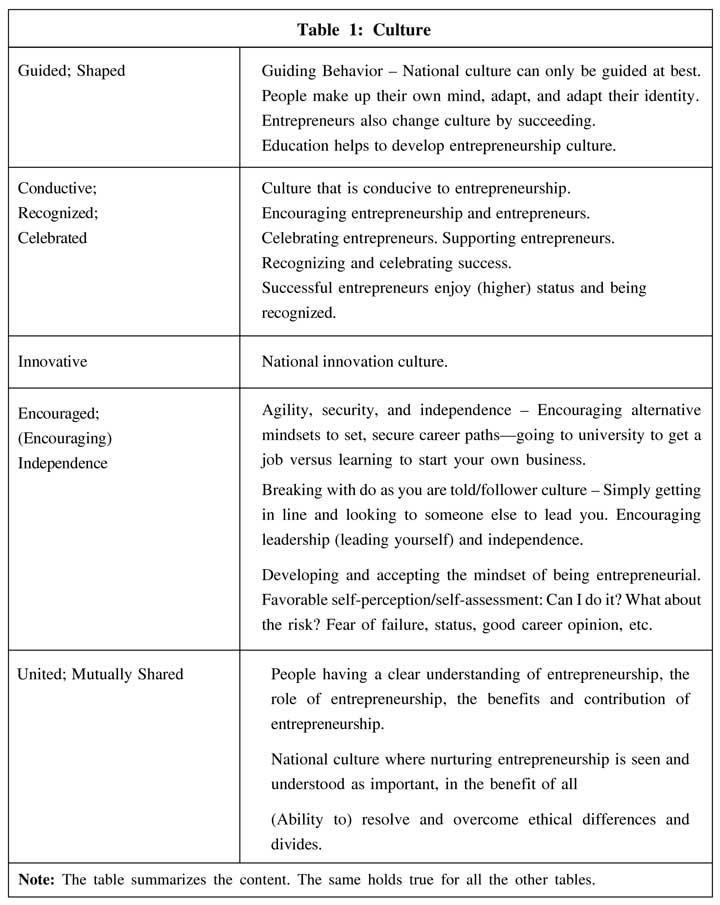
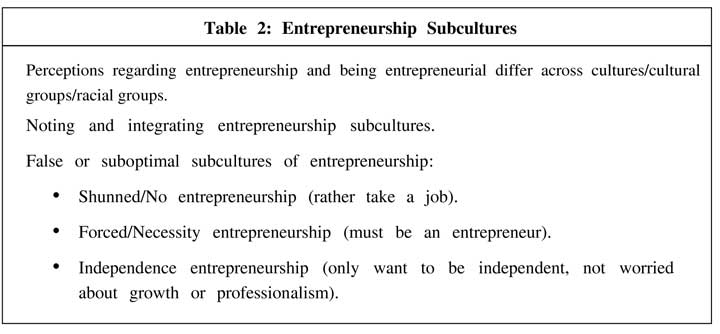
Politics
Entrepreneurship must be void of political agendas and power plays (Table 4). Entrepreneurship policy must not be politically motivated. Politics should value and support entrepreneurship, and get behind entrepreneurship. Entrepreneurship must be seen as part of the (political) solution. It is important for government to fully understand entrepreneurship. A balance must be found, as true entrepreneurship is neither capitalist nor socialist. Populist politics is seldom conducive to entrepreneurship. Politics should demonstrate economic sense. In a sense, politics should be blind when it comes to entrepreneurship. Situations where politics has power or say over, and gets in the way of entrepreneurship and economic affairs must be avoided. Political rhetoric must support entrepreneurship. Politics that demonstrates leadership will look to create top-quality entrepreneurial eco-systems, will pen intelligent entrepreneurship policy, and create momentum behind entrepreneurship. Strong leadership in politics will also imply and result in political leadership being able to drive and set direction for markets and industries. Entrepreneurship requires both strong policy, and implementation. The business competency and skill of government are just as important.
National and regional politics are still aligned according to superpowers and their ideologies. There is more of a move away from strong ideology, like capitalism or socialism, towards pragmatism-actual results and a growth model that works. Politics involves achieving some balance between intervention and a free market (Table 5).
Leadership
Entrepreneurship benefits when it is driven from the top (Table 6). Direction should be set by communicating the state of affairs and what is required to improve on it. A clear vision must be set for entrepreneurship, and must be communicated and driven. It must be ensured that everyone works together and pulls in the same direction (Inayatullah, 2003). Leadership also involves building momentum and support behind entrepreneurship. Focus should be on increasing the pie-each one's share-finding solutions, and improving on the current system. Entrepreneurship should be a national priority. True leadership of entrepreneurship requires a solid and expert understanding of entrepreneurship, as well as economic or business acumen (smarts/intellect). The impact of decisions on entrepreneurship must be considered, and Entrepreneurship benefits when it is driven from the top (Table 6). Direction should be set by communicating the state of affairs and what is required to improve on it. A clear vision must be set for entrepreneurship, and must be communicated and driven. It must be ensured that everyone works together and pulls in the same direction (Inayatullah, 2003). Leadership also involves building momentum and support behind entrepreneurship. Focus should be on increasing the pie-each one's share-finding solutions, and improving on the current system. Entrepreneurship should be a national priority. True leadership of entrepreneurship requires a solid and expert understanding of entrepreneurship, as well as economic or business acumen (smarts/intellect). The impact of decisions on entrepreneurship must be considered, and entrepreneurship must be considered when taking decisions. Instead of leaving it to fend for itself, entrepreneurship must be nurtured. Entrepreneurship practice should be pitched-operated and measured-against world-class standards. Leadership of entrepreneurship involves bringing all of entrepreneurship's stakeholders together, understanding the objectives of each, finding common ground through communication and dialogue, and directing the discussion and dialogue. This already may require mature levels of leadership. It also requires key decisions to be made at key points in time. Entrepreneurship leadership is also transformative-breaking with vicious cycles, unsustainable or unfair behavior, and continuing with transformation, where it is still needed.
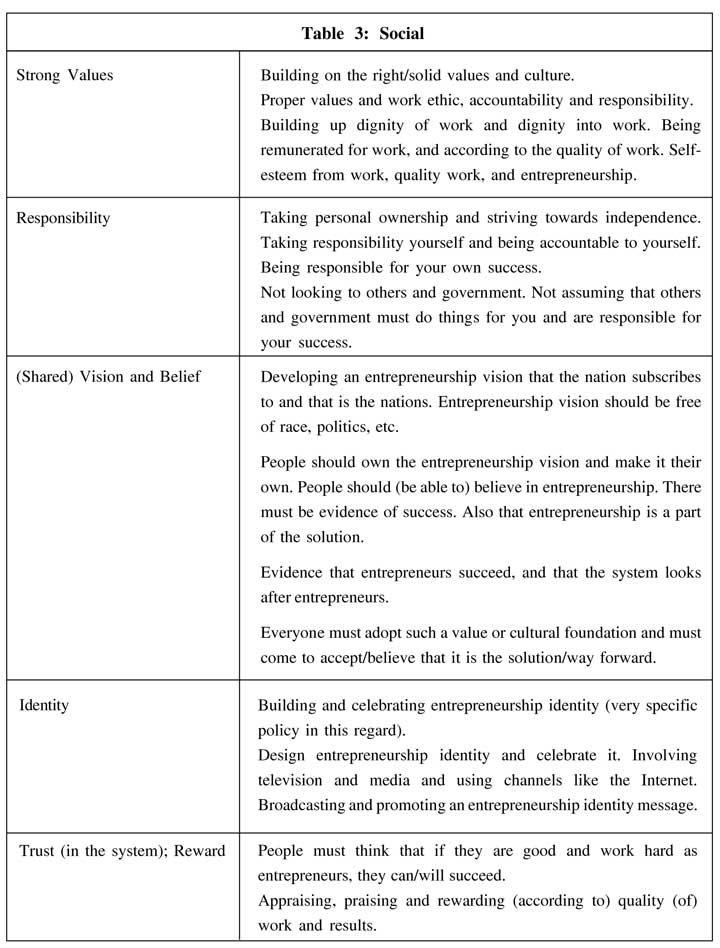
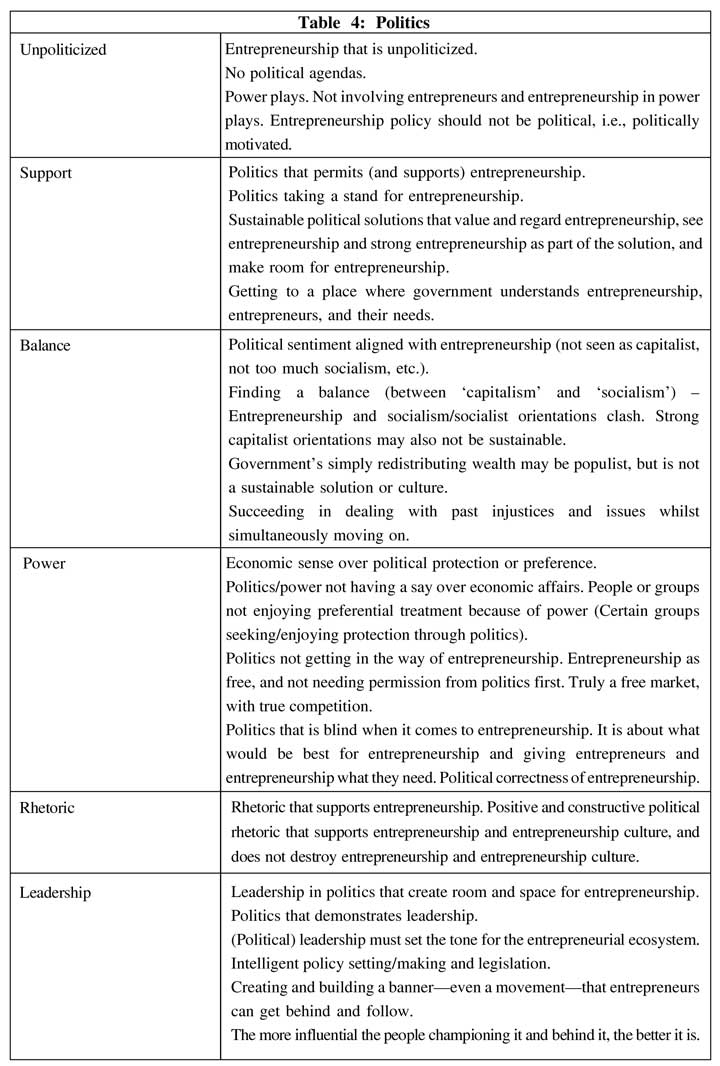
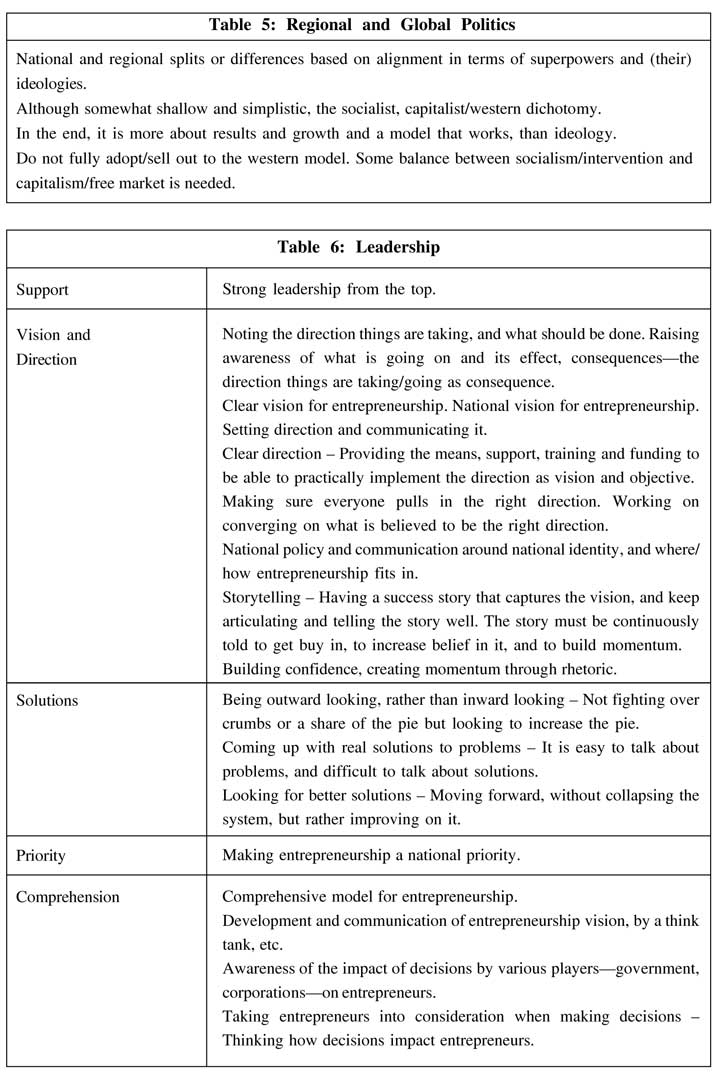
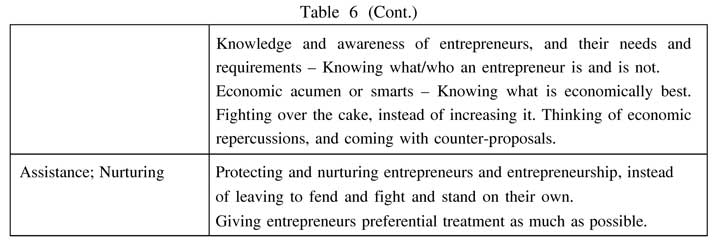
Corporate
Entrepreneurship requires corporations to support entrepreneurship, and for corporations to be willing to work with entrepreneurs, but with the appropriate attitude. To improve the competitive landscape, existing power structures are frequently re-evaluated. Corporations can incorporate the innovation of entrepreneurs, by building joint ventures around it (Table 7).
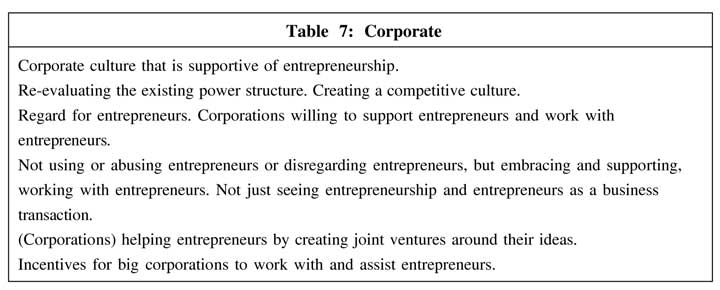
Spiritual
Entrepreneurship should be seen and regarded as an integral part of society, and entrepreneurs should be commended for their contribution to society, meaning it is also very clear how entrepreneurs contribute to the prosperity of society. It requires that the success of others are not envied (Table 8).
Environment
Entrepreneurship requires both an attractive and conducive environment (Table 9). An attractive environment entails making the country a haven and very open to/for entrepreneurs. Entrepreneurs and entrepreneurship are encouraged. Entrepreneurship is highly valued and regarded, and the right values and behavior-innovative and hard work-are rewarded. The system is very transparent and fair, and immoral or unethical behavior is removed. Everyone is given a chance, with no preferential treatment, and people are allowed to enjoy their success. Competition is valued and encouraged. Entrepreneurs are provided with everything they need, and it is made as easy and simple as possible for entrepreneurs. Entrepreneurs are offered protection, and their ideas and intellectual property are protected. Quality is highly regarded, and benchmarked to the best globally. Entrepreneurship is properly measured and evaluated, and thus managed. Experienced people are incorporated into the entrepreneurship system, to increase the expertise thereof. The entrepreneurship system is made very competitive and raised to high quality: accurate tools and competencies are developed for entrepreneurship. Entrepreneurship is made and run independent and independently. Business-minded individuals are let to run the entrepreneurship system. Government has a supportive role, but its involvement is only indirect. Government merely relays its objectives, moderates the system, and does not directly get involved, but leaves implementation to the private sector.
Startup is made as easy and simple as possible, with compliance and requirements kept to the bare minimum. The administrative burden on the entrepreneur is made as little as possible, and the entrepreneur is provided with ample assistance in this regard. Entrepreneurs are also given a lot of leniency in terms of regulation and compliance, during the start-up phase, while they still grow and develop. Regulation and compliance are adjusted and stepped, according to the stage, phase, and development of the startup and SME.
The entrepreneur is assisted with funding, and his risk is shifted and adjusted. Ways in which entrepreneurs are assisted with funding, include subsidized and underwritten SME loans, essentially incentivizing private institutions to provide loans to SMEs. Securing and underwriting the loans of SMEs, reduce the risk of SMEs, and de-risk SMEs. There are a lot of opportunities for public-private partnerships, when it comes to funding SMEs, and assisting SMEs with funding. The objective is mostly to incentivize the already efficient private institutions to extend their services to SMEs. Government can assume some of the risk associated with SME loans, to bring it more in line with a typical business risk profile
(Table 10). (Table 11). Entrepreneurs can be made aware of government assistance available, through technology. Technology will also allow a database of SMEs-government-backed and otherwise. This implies accurate record-keeping of entrepreneurs. Entrepreneurs can be automatically assigned a bank account, and the registration and start-up process can be made very easy and simple.

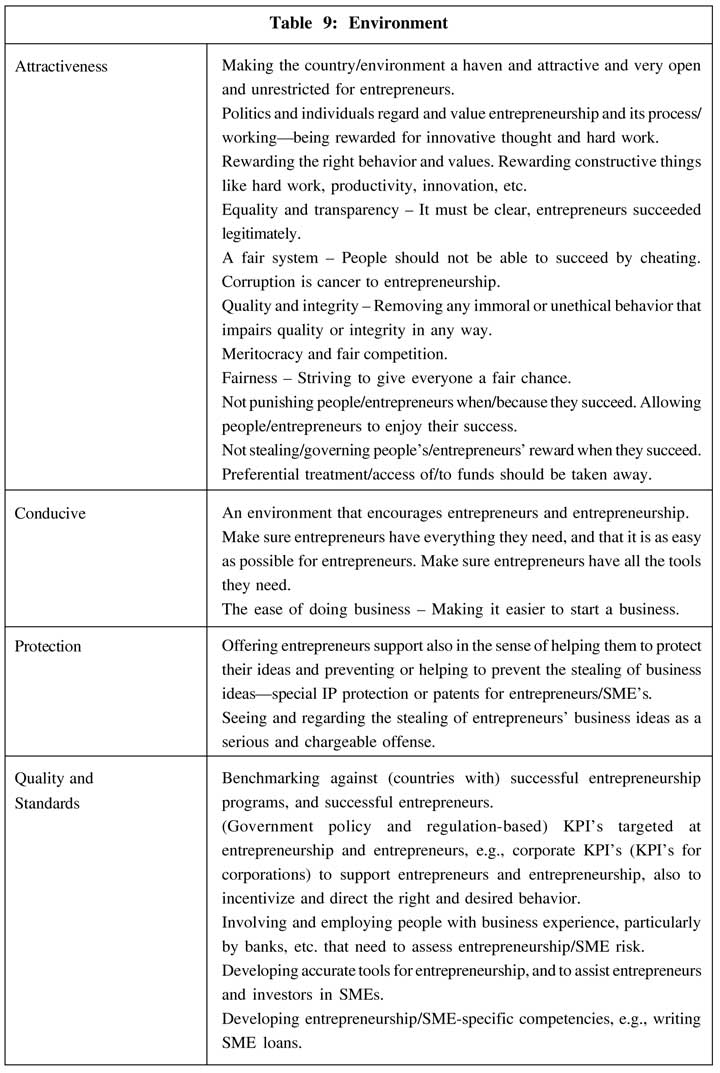
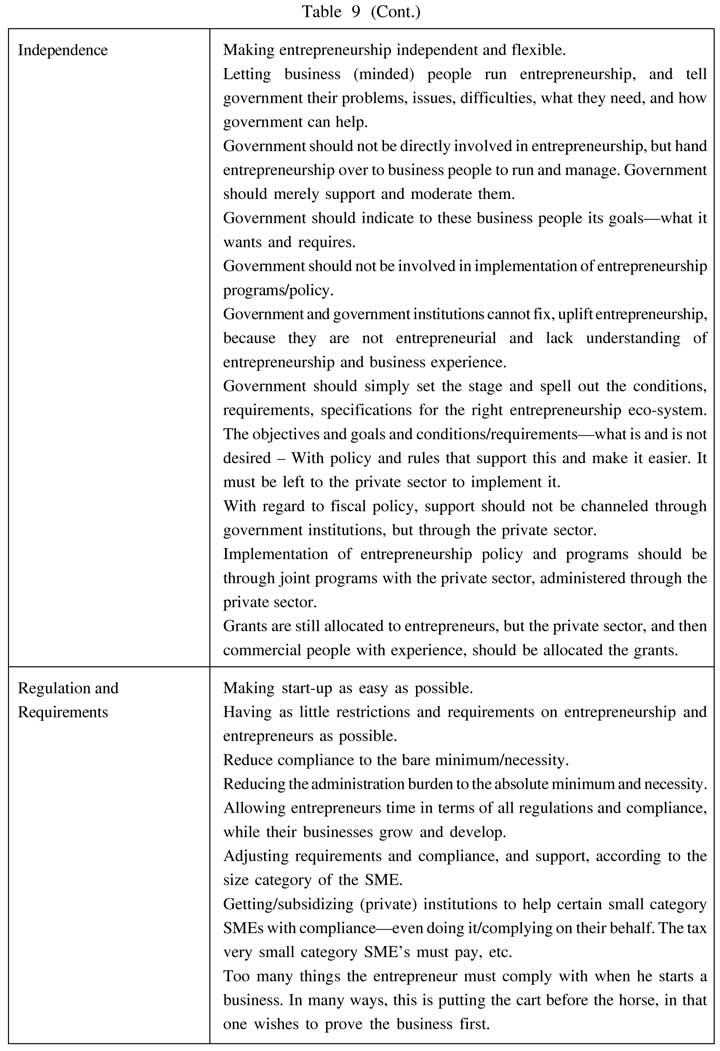
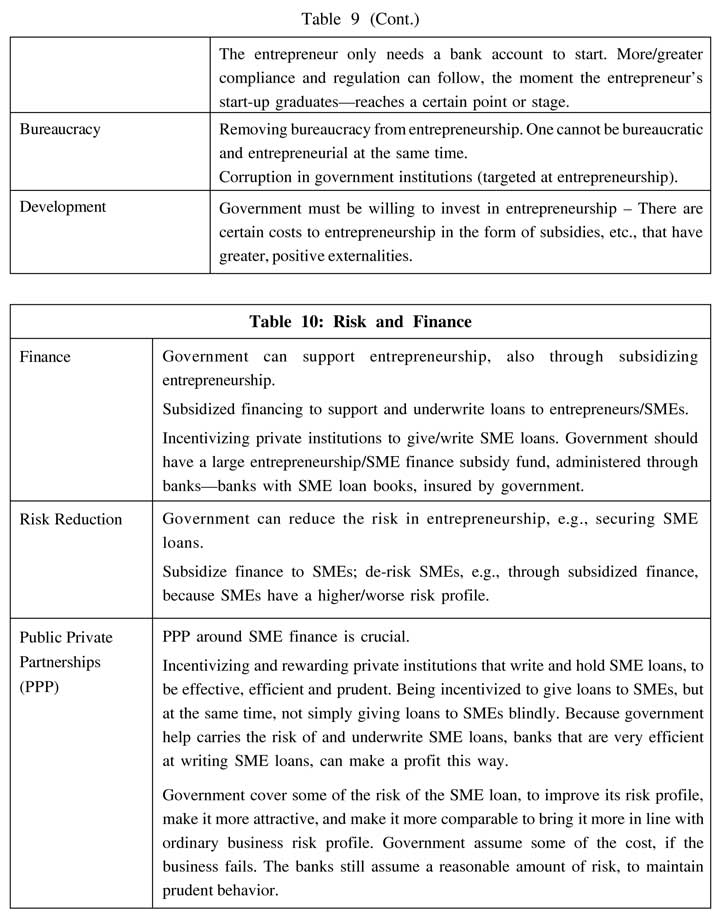
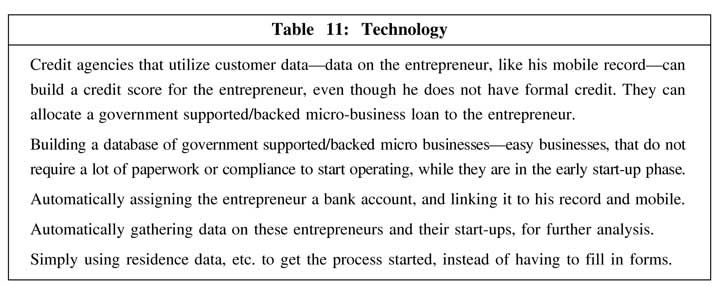
Infrastructure
Entrepreneurship requires the basic infrastructure-banking, finance, and communication infrastructure and systems-to be in place (Table 12). It also requires that appropriate business infrastructure is in place-the ability to provide focused help. The appropriate programs should be in place. One-stop business support centers should be able to provide support to entrepreneurs, and serve as an access point for information and assistance.
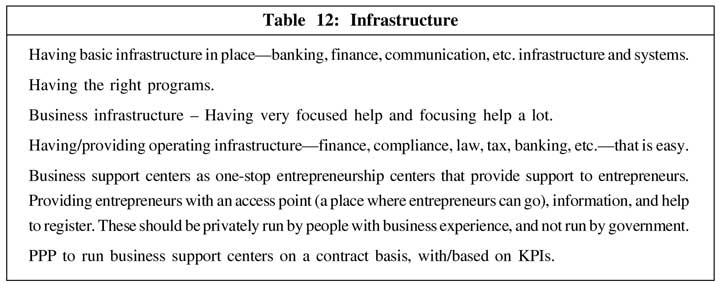
Education
Although less immediate, education has a significant and marked impact on entrepreneurship, and entrepreneurship education cannot be emphasized enough (Table 13). Entrepreneurship should be made part of, and incorporated into education. Students should be prepared and taught to be entrepreneurs and entrepreneurial, and their understanding of entrepreneurship should be developed (Slaughter, 1998). Students should be exposed to entrepreneurship more, and be given more practical exposure (Whitty, 2001).
Entrepreneurship should be regarded and stand out as a viable career path. Overall, it should be ensured that education and human development are up to date and at par. Given the latest developments, there is a lot that can be done in this regard.
Technology
Technology enables and permits a lot, yet should be accompanied with responsibility, and its development must be guided, to ensure that it remains constructive (Table 14). Technology affects the social fabric, and it must be ensured that technology instills and maintains the right values and culture (Botta and Abbasi, 2015). The effect and consequences of (new) technology should be considered, and it may require regulation. Technology equally affects power structures, sometimes in a positive manner, and sometimes in a negative manner. Technology opens the door to a lot of opportunity for entrepreneurship.
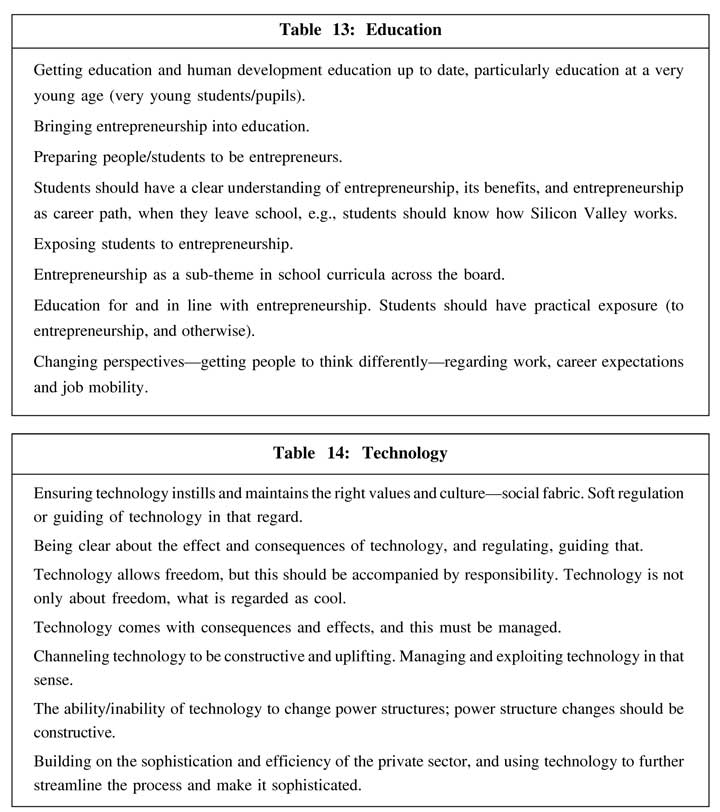
Economics
With regard to the economics of entrepreneurship, at the macro level, a multi-layered approach is common: at the lower levels, a more pure entrepreneurial and free-market approach, that focuses on initiative, competition, and innovation, is followed. At the higher levels, government intervention and planned markets offer concrete benefits. Among others, free enterprise and reward for hard work remain principal premises of entrepreneurship. It may not always be that easy to change the economic system and setup, without it being met with a lot of instability and upheaval, and economic transformation may thus be slow. Certain economic ideologies, like the western approach, may be in transition and flux (Table 15).
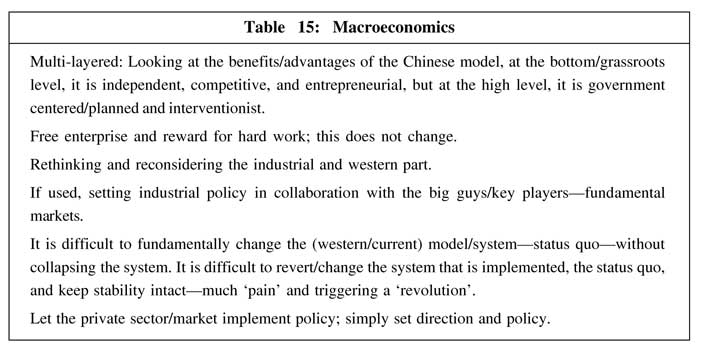
At the micro or market or industry level, the economics of entrepreneurship fundamentally involves a balancing of objectives (Table 16). Profit-related objectives cannot be realistically given free reign and must be balanced against non-profit-related objectives. One the one hand are profit and efficiency objectives, and on the other hand are development objectives. Markets cannot truly be allowed to be free market, without complications, and markets cannot really be left and expected to regulate and sort out themselves. Therefore, some degree of planned markets are desirable. The power corporations allowed, the number of corporations, the extent of regulation required, and non-profit objectives to introduce, are all issues and aspects to consider and resolve. Markets or industries must be simultaneously competitive and efficient, and protected. Even though it may sound attractive, the notion of entirely open markets are dangerous.
Entrepreneurs should be assisted in terms of access to markets-getting a chance. In addition to access to markets, another option is of course access to supply chains. Regulation can be used to give entrepreneurs access to markets. Providing entrepreneurs access to markets may require a shift or change-rebalancing-in the market itself.
Economies, like scale or scope economies, and context are very relevant, and must be kept in mind, when considering support for entrepreneurs. In some cases, contexts and markets, it makes sense to introduce entrepreneurs, and in some it does not really, in that it will rather lead to unproductive and inefficient setups and configurations. Following an ideology and philosophy of doing what is best for the country, may be rewarding. Some current market setups may not necessarily be ideal, and it may be beneficial to introduce entrepreneurship and entrepreneurs to certain contexts and markets. Certain inefficient and unnecessary monopolies can be broken up, also by requiring to establish corporations to work with and support entrepreneurs and entrepreneurship. Another dominant focus should be ensuring competition based on quality and value, as this is not necessarily guaranteed. Competition can be made to be a lot more service, quality, value, and innovation-based, rather than (being) size or muscle-based (Dator and Seo, 2004). Offering support and access to markets do not necessarily imply removing competition.
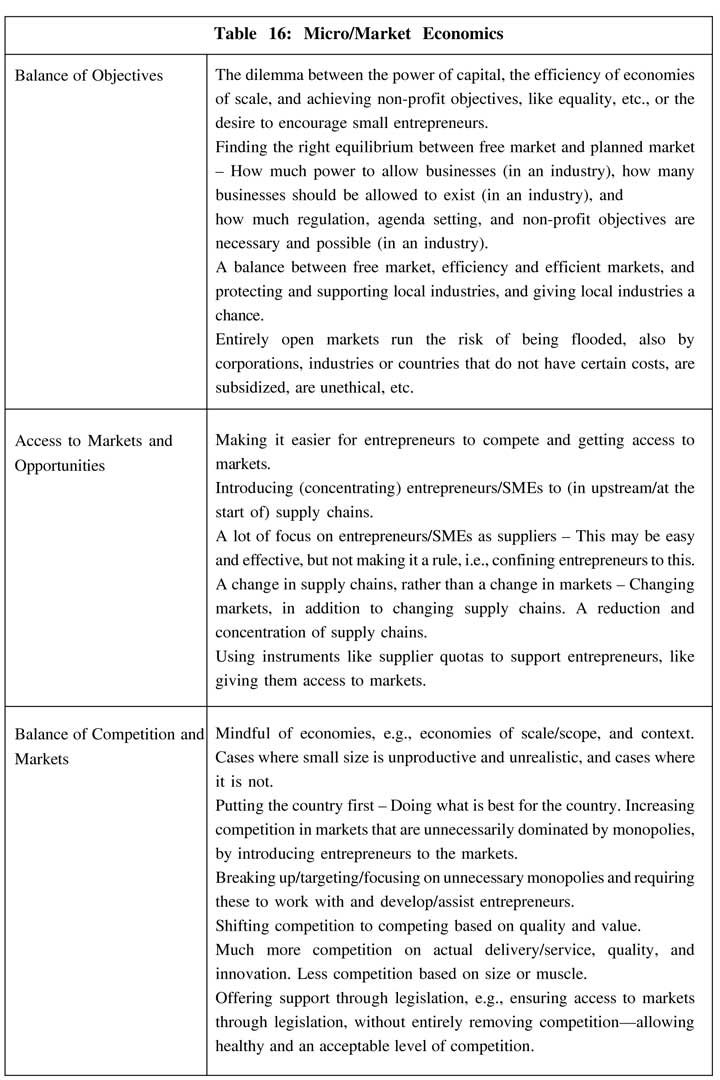
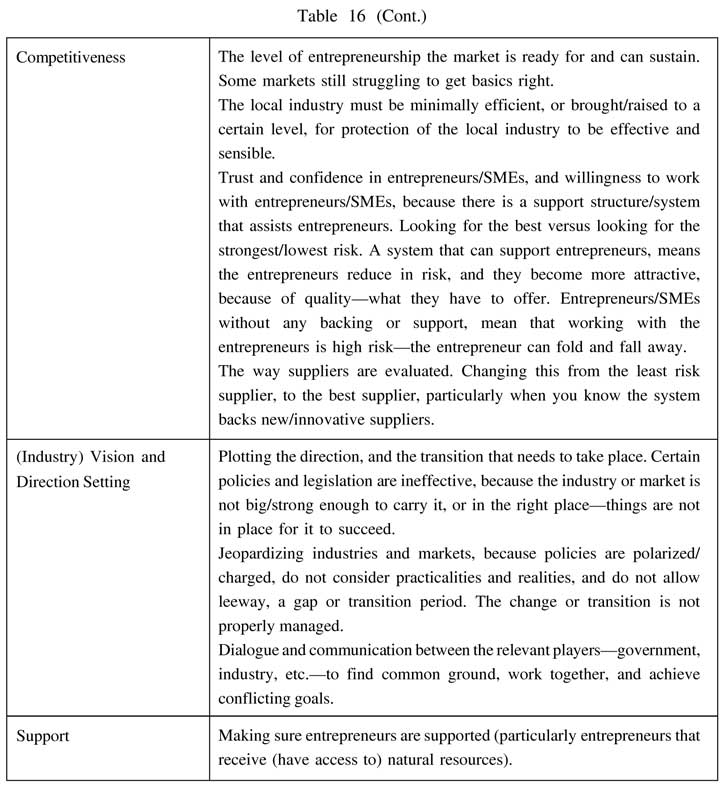
Markets themselves determine the level and extent of entrepreneurship possible and that can be supported. Certain markets must still be developed in terms of capacity and competency. Market protection may be sensible, for development and other reasons, but then the market must be minimally competitive. A support structure for entrepreneurs and SMEs, will help with trust and confidence in SMEs and their capacity. This too would raise the attractiveness of SMEs as partners. SMEs are generally attractive as innovative suppliers, and the best suppliers, but less so in terms of capacity and security or reliability. SMEs may be the best supplier, yet not the lowest risk supplier.
As with entrepreneurship in general, markets and industries require vision and direction setting, highlighting the direction to take, and the transition that is required. Vision and direction can significantly aid entrepreneurship in a particular market or industry. Policies are not always appropriate and practical for a particular market or industry. Vision and direction setting requires communication between the relevant stakeholders.
To succeed, entrepreneurs must be adequately supported, and support may entail more than just access to markets.
A fine balance exists and must be maintained between entrepreneurship and resources (Table 17). Left unchecked, resources may be overly exploited, to the point that it becomes a social cost. To be sustainable, the rules of the game must be stipulated, and requires regulation. It consequently raises the issue of enforcement of legislation. Again, there is a fine balance between under-regulating (unsustainable) and over-regulating (stifling).
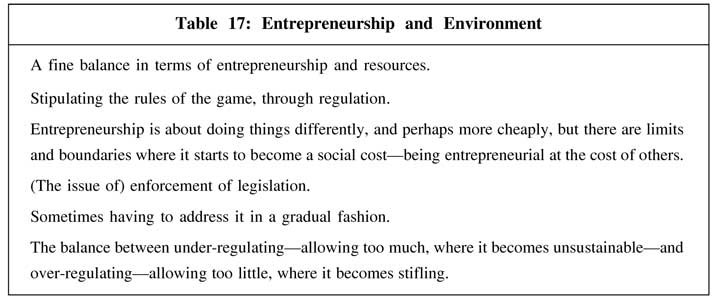
Entrepreneurship-Specific Support
Finance significantly affects the capacity and competitiveness of entrepreneurs (Table 18). Entrepreneurs may require various means and forms of (help with) financing, e.g., bridging or trade finance. In some instances, like services, this may even be more the case.
A lot of potential and opportunity exist for technology to further aid and support entrepreneurship (Table 19). Fintech in the context of entrepreneurship may hold a lot of promise. Fintech can improve entrepreneurship processes and systems, and render them more efficient. It can also avail and exploit a lot of entrepreneurship-related data and information. Overall, there should be benefit in bringing entrepreneurship support systems and platforms online. Government policies and programs can be integrated into entrepreneurship systems, to improve their effectiveness. Technology can further empower entrepreneurs, and increase the efficiency and effectiveness of entrepreneurship support. Technology should be able to improve entrepreneurs' access to finance. Technology should also be able to shorten common entrepreneurship processes and procedures.
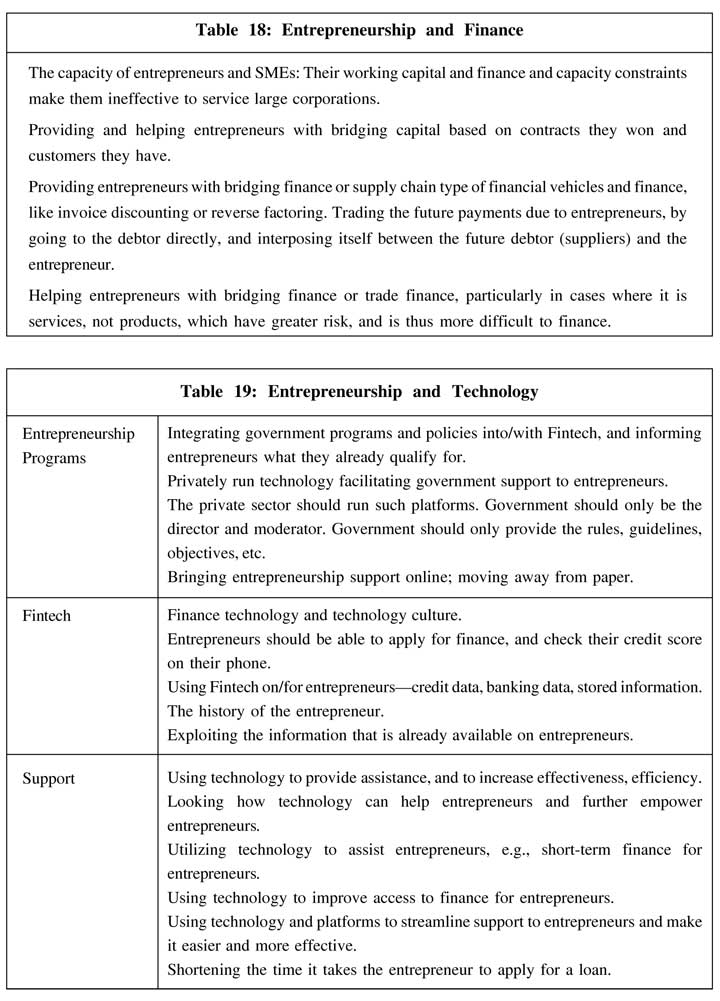
Importantly, general entrepreneurship support entails business support centers that can provide quality assistance and guidance to entrepreneurs (Table 20). An efficient entrepreneurship program may equally involve effectively screening entrepreneurs and determining who is ready for support, and who is not, to make the best use of resources, and also, providing entrepreneurs with quality information. It may be necessary to push the private sector, through legislation, to overcome complacency, and to improve market development and efficiency, as markets may not necessarily be incentivized on their own.
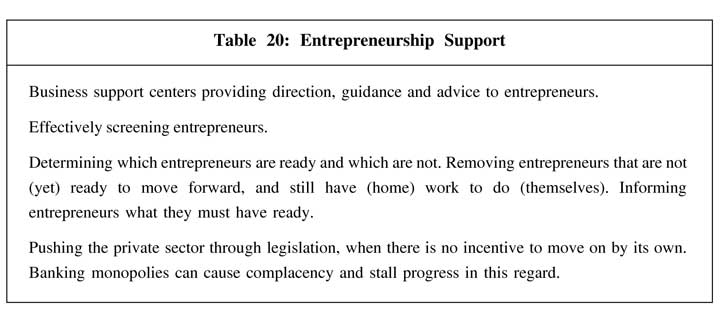
SE or futures studies offer a unique perspective on entrepreneurship, because its focus is different. It has in common with other (types of) studies the ideal conditions of entrepreneurship. At the same time, it differs from other studies, in that it provides greater freedom to explore these, because it allows a break from the present. Also, its perspective may be more relevant, as it breaks from the present (constraints), and rather focuses on what would be relevant in the future. This is an important and simultaneously practical difference.
Not all of the participants had a holistic understanding of SE and its requirements, but were mostly experts in their particular area, and less competent in certain other areas outside their specialty or interest. Participants had varying degrees of knowledge regarding their perception and sense of future studies and strategic foresight. Culture conducive to SE must be shaped to a large extent. SE culture values and celebrates entrepreneurship. It is equally a very independent (self-reliant) and innovative culture.
SE requires solid foundation and strong values to build on. It is important to regard, recognize and reward the right things. SE seeks a shared vision of/for and belief in entrepreneurship.
Entrepreneurship must be regarded as an integral part of society, and entrepreneurs should be commended for their contribution to society. It should be possible to enjoy one's successes.
Entrepreneurship must be void of political agendas and power plays. Entrepreneurship policy must not be politically motivated. Politics should value and support entrepreneurship and get behind entrepreneurship. Entrepreneurship must be part of the (political) solution. It is important for government to fully understand entrepreneurship. A balance must be found, as true entrepreneurship is neither capitalist nor socialist. Politics should not have a say over, or get in the way of, entrepreneurship. Politics should demonstrate true leadership, capable of setting vision and direction (for entrepreneurship), and political rhetoric should support entrepreneurship. Entrepreneurship requires both strong policy and implementation. The business competency and skill of government are just as important.
Entrepreneurship must be driven from the top, by top leadership, and requires (clear) vision and direction. Unity in the sense of people working together on common goals is important. Focus should squarely be on increasing the pie-everyone's share. Leadership should build momentum behind entrepreneurship. Leadership requires strong business acumen and must be sensitive to entrepreneurship and its requirements. Emphasis should be on (the) quality (of) entrepreneurship. It is leadership's role to bring together the stakeholders of entrepreneurship. Leadership should move entrepreneurship forward.
Entrepreneurship depends on cooperation with corporations, and a frequent re-evaluation of power structures; such a culture must be cultivated. The environment of entrepreneurship must be cultivated and built up to be both attractive and conducive. In general, this entails offering proper support, incentivizing the appropriate behavior, a transparent and fair system, an emphasis on quality, and minimizing the burden on entrepreneurs as much as possible.
To a large extent, SE implies a system run by the private sector, and only supported by government. SE also can entail financial assistance to entrepreneurs and improving the risk profile of entrepreneurship.
SE also implies high technology systems to render the entrepreneurship (eco-) system very efficient, and to get the most out of it. It requires basic infrastructure and business infrastructure to be in place. This includes the ability to provide focused help to entrepreneurs.
Although less immediate, education has a significant impact on entrepreneurship. Entrepreneurship should be incorporated into education. Students should be exposed to entrepreneurship more. Entrepreneurship should be regarded as a viable career path.
Technology promises and unlocks a lot, but requires responsibility.
SE can follow a multi-layered approach at the lower levels, following a purer entrepreneurial and free market approach that focuses on initiative, competition, and innovation, with government intervention and planned markets at the higher levels. Free enterprise and reward for hard work remain principal premises of entrepreneurship. Certain economic ideologies may be outdated and on the way out.
At the micro level, the economics of entrepreneurship fundamentally involves balancing of profit and non-profit objectives. Markets cannot truly be allowed to be free market without complications, and require intervention and oversight (leadership). It must be ensured that the system is always balanced. To help with this, entrepreneurs should be provided with opportunity in markets, where it makes sense. The over-arching ideology should be that of doing what is best for the country. Another dominant focus should be ensuring competition based on quality and value. Competition can be made more service, quality, value, and innovation-based. A support structure for entrepreneurs increases their competitiveness.
(Access to) finance significantly affects the capacity and competitiveness of entrepreneurs. A lot of potential and opportunities exist for technology to further aid and support entrepreneurship. Entrepreneurship support entails business support centers that can provide quality assistance and guidance to entrepreneurs.
Limitations:
The present study suffers from certain limitations:
- The sample data investigated is usually of a small size, therefore proving it hard to obtain information that meets the criteria for broad representation.
- The research could not be generalized, but still aids in providing salient insights into the views and experiences of a well-versed group.
- Due to its subjective nature, it is hard to separate the researcher's personal views and interpretations from the data collection.
Scope for Future Studies: Future research can look further at the following:
- SE and methodology: Conducting the same research, but through different methodologies, like focus groups and action research.
- The benefit and contribution of SE research: Investigating people's response to SE research, and its impact on their perceptions-how (participating in) SE research, and thinking on SE in future studies and strategic foresight sense and context, impact people's perceptions, outlooks, thinking and focus, and the benefit they derive from it.
- The level of foresight of entrepreneurship leaders and professionals, i.e., the extent to which the leaders and professionals demonstrate strategic foresight and competency in this regard.
- Leadership and SE: Given that it constitutes a dominant theme, leadership in the context of entrepreneurship and SE can be investigated further.
- SE and its scope: Many, if not all, of the aspects or facets covered by the research can be advanced and developed further at greater depth to increasingly examine their impact on and contribution to SE. Examples of this are culture, economics, politics, technology,
References
- Acemoglu D and Robinson J A (2012), Why Nations Fail: The Origins of Power, Prosperity and Poverty, Crown Publishing Group, London.
- Anderson W T (2004), "Evolution and Enlightenment: The Conceivable Convergence", Journal of Futures Studies, Vol. 9, No. 1, pp. 75-82.
- Barnatt C, Starkey K and Tempest S (2016), "Remember Icarus! Seven Risks that Threaten Business Schools", Journal of Futures Studies, Vol. 21, No. 1, pp. 63-76.
- Bell J (2014), Doing Your Research Project: A Guide for First-Time Researchers, McGraw-Hill Education, UK.
- Blaikie N (2000), Designing Social Research: The Logic of Anticipation, Polity Press, Cambridge.
- Blass E (2013). "Women Branded Liar by High Court Judge: Leadership, Professionalism and Ethics for the Future", Journal of Futures Studies, Vol. 17, No. 3, pp. 65-80.
- Blaxter L, Hughes C and Tight M (2006), How to Research, 3rd Edition, Open University Press, Berkshire.
- Botta M and Abbasi A (2015), "Armed Conflict Versus Global Sustainable Development as Functions of Social Change", Journal of Futures Studies, Vol. 19, No. 4, pp. 51-72.
- Burke R (2011), "The Rise and Fall of Growth: The Inappropriateness of Continuous Unchecked Growth", Journal of Futures Studies, Vol. 16, No. 1, pp. 79-100.
- Chung C M (2001), "Transforming Learning for the Future", Journal of Futures Studies, Vol. 6, No. 1, pp. 169-181.
- Cook C N, Inayatullah S, Burgman M A et al. (2014), "Strategic Foresight: How Planning for the Unpredictable Can Improve Environmental Decision-Making", Trends in Ecology & Evolution, Vol. 29, No. 9, pp. 531-541.
- Cordeiro J L (2003), "Future Life Forms Among Posthumans", Journal of Futures Studies, Vol. 8, No. 2, pp. 65-72.
- Cruz S and Villanueva C H (2014), "City Futures for City Leaders Penang Malaysia", Journal of Futures Studies, Vol. 19, No. 1, pp. 115-125.
- Darlington Y and Scott D (2002), Qualitative Research in Practice: Stories from the Field, Open University Press (First Published in 2002 by Allen and Allen, Australia), Maidenhead.
- Dator J and Seo Y (2004), "Korea as the Wave of a Future", Journal of Futures Studies, Vol. 9, No. 1, pp. 31-44.
- Demneh M T and Morgan D R (2018), "Destination Identity: Futures Images as Social Identity", Journal of Futures Studies, Vol. 22, No. 3, pp. 51-64.
- Dian N (2003), "The Future of Education in a Season of Change", Journal of Futures Studies, Vol. 7, No. 3, pp. 7-14.
- Gale S, Leonardo T, Sato M and D'Cruz J (2015), "Asian Urbanization Futures: Nine Practitioner Recommendations", Journal of Futures Studies, Vol. 19, No. 4, pp. 99-102.
- Harrell M C and Bradley M A (2009), Data Collection Methods: Semi-Structured Interview and Focus Groups, RAND National Defense Research Institute, Santa Monica.
- Herrington M, Kew P and Mwanga A (2017), Global Entrepreneurship Monitor: South Africa Report 2016/2016.
- Hoffman J (2014), "Alternative Images of China in 2035: A Case Study of Tamkang University Workshops", Journal of Futures Studies, Vol. 19, No. 1, pp. 13-34.
- Inayatullah S (2001), "Eco-Bots in Your Future: The Future of the Middle-Man", Journal of Futures Studies, Vol. 5, No. 4, pp. 129-134.
- Inayatullah S (2003), "Does War Have a Future", Journal of Futures Studies, Vol. 8,
- 1, pp. 111-114.
- Inayatullah S (2006), "Anticipatory Action Learning: Theory and Practice", Futures, Vol. 38, No. 6, pp. 656-666.
- Judith A (2004), "Coming of Age in the Heart: Cultural Evolution and the Initiation of Our Time", Journal of Futures Studies, Vol. 9, No. 1, pp. 83-88.
- Kapoor R (2011), "Global Megacrisis and Response: A Perspective from India", Journal of Futures Studies, Vol. 16, No. 2, pp. 139-142.
- Kelleher A (2005), "Corporations and Global Governance: A Multi-Cultural Futures Perspective", Journal of Futures Studies, Vol. 10, No. 1, pp. 49-62.
- Kelly P (2003), "Market Wants, World Needs", Journal of Futures Studies, Vol. 7, No. 3, pp. 51-54.
- Kumpe T and Chen K H (2014), "Towards the Creation of Wiser Futures: Sino-Africa Relations and Futures of African Development", Journal of Futures Studies, Vol. 19, No. 2, pp. 1-20.
- Malhotra N K and Birks D F (2003), Marketing Research: An Applied Approach, Pearson Eduction Limited, Harlow.
- Porter A L, Ashton W B, Clar G et al. (2004), "Technology Futures Analysis: Toward Integration of the Field and New Methods", Technological Forecasting and Social Change, Vol. 71, No. 3, pp. 287-303.
- Putterman L (2013), "Book Review 'Why Nations Fail: The Origins of Power, Prosperity, and Poverty' by Daron Acemoglu and James A Robinson", Economic Development and Cultural Change, Vol. 61, No. 2, pp. 470-472.
- Ramos J M (2006), "Dimensions in the Confluence of Futures Studies and Action Research", Futures, Vol. 38, No. 6, pp. 642-655.
- Ramos J (2017), "Cosmo-Localization and Leadership for the Future", Journal of Futures Studies, Vol. 21, No. 4, pp. 65-83.
- Ratcliffe J and Ratcliffe L (2015), "Anticipatory Leadership and Strategic Foresight: Five 'Linked Literacies'", Journal of Futures Studies, Vol. 20, No. 1, pp. 1-18.
- Ritchie J, Spencer L and O'Connor W (2003), Qualitative Research in Practice: A Guide for Social Science Students and Researchers, Sage, London.
- Robinson J B (1990), "Futures Under Glass: A Recipe for People Who Hate to Predict", Futures, Vol. 22, No. 8, pp. 820-842.
- Slaughter R A (1997), "Developing and Applying Strategic Foresight", ABN Report, Vol. 5, No. 10, pp. 13-27.
- Slaughter R (1998), "Universities as Institutions of Foresight", Journal of Futures Studies, Vol. 1, No. 3, pp. 51-57.
- Tibbs H (2011), "Changing Cultural Values and the Transition to Sustainability", Journal of Futures Studies, Vol. 15, No. 3, pp. 13-32.
- Turner D W (2010), "Qualitative Interview Design: A Practical Guide for Novice Investigators", The Qualitative Report, Vol. 15, No. 3, pp. 754-760.
- Whitty M (2001), "Reinventing Education and Saving Our Children and Our Planet", Journal of Futures Studies, Vol. 5, No. 4, pp. 49-64.
- Willig C (2008), Introducing Qualitative Research in Psychology, 'Adventures in Theory and Method', 2nd Edition, McGraw-Hill, Maidenmead.